Viking Age coins found in Finland
Thousands of Viking Age coins have been found in Finland, having been brought to the country approximately between the 9th and 11th centuries. Most of the prehistoric coins come from various hoards, but coins have also been found in graves and as individual finds. A significant part of the Viking Age coin finds in Northern Europe and Finland is made up of Islamic dirhams and Anglo-Saxon and German pennies. Some Byzantine, Bohemian and Danish coins, for example, have also been found in Finland.
The earliest Viking Age coins brought to the region of Finland are Persian drachmas. Drachmas are rare in Finnish finds and have only been found in hoards in Åland. Oriental dirhams are much more common. Umayyad and Abbasid dirhams from the Middle East, as well as Central Asian Samanid dirhams, are the most common types of dirhams found in Finland. Dirhams contain religious text in Arabic, information about the minting location and often also the ruler who struck the coin, and the year according to the Islamic calendar. The average weight of Islamic coins is between two and three grams, and their diameter is approximately 20–30 mm.
As the number of Islamic coins brought to the region of Finland declined in the mid-10th century, more and more Western European silver coins, especially German and English pennies, started appearing here. These pennies weigh approximately one gram and have an average diameter of 15–20 mm. English coins can often be accurately dated, with information about the ruler who struck the coin, the minting location and the moneyer. The minting patterns were also changed regularly, approximately every six years. In particular, many coins struck by King Æthelred II the Unready (978–1016) and Cnut the Great (1016–1035) have been found in Finland.
Of the Viking Age coins, German coins are among the most difficult to identify and date. They are often in a poorer condition than English pennies, and there are thousands of different variations and imitations of them. German coins were struck in several cities in Central Europe, particularly by kings and bishops, but sometimes also by dukes and counts, for instance. The most common German coins found in the region of Finland are so-called wooden church pennies, which were made especially for trade with the Nordic countries.
The coins came to the region of Finland as a result of trade and exchange. Payment was made according to the weight of silver, meaning that the value of money was based on its weight and not on the number of individual coins or their nominal value. Coins could be split into halves or quarters as necessary. Some coins also show other signs of use, such as bends, cracks and cuts. Holes and loops fastened with rivets indicate the use of coins as jewellery.
Reproductions and imitations of coins have also always been made. Around the year 1000, coins were produced in Scandinavia according to English models. Coins were probably also imitated in the region of Finland. However, these imitations were not made for financial gain, but the signs of use on the coins and the fact that they are most often found in graves indicate that the imitations were worn as jewellery. The creators of the reproductions may have made intentional or unintentional mistakes due to a lack of literacy, language and writing skills.
This selection was curated by trainee Jasmin Ruotsalainen in summer 2021.
Select an image for more information
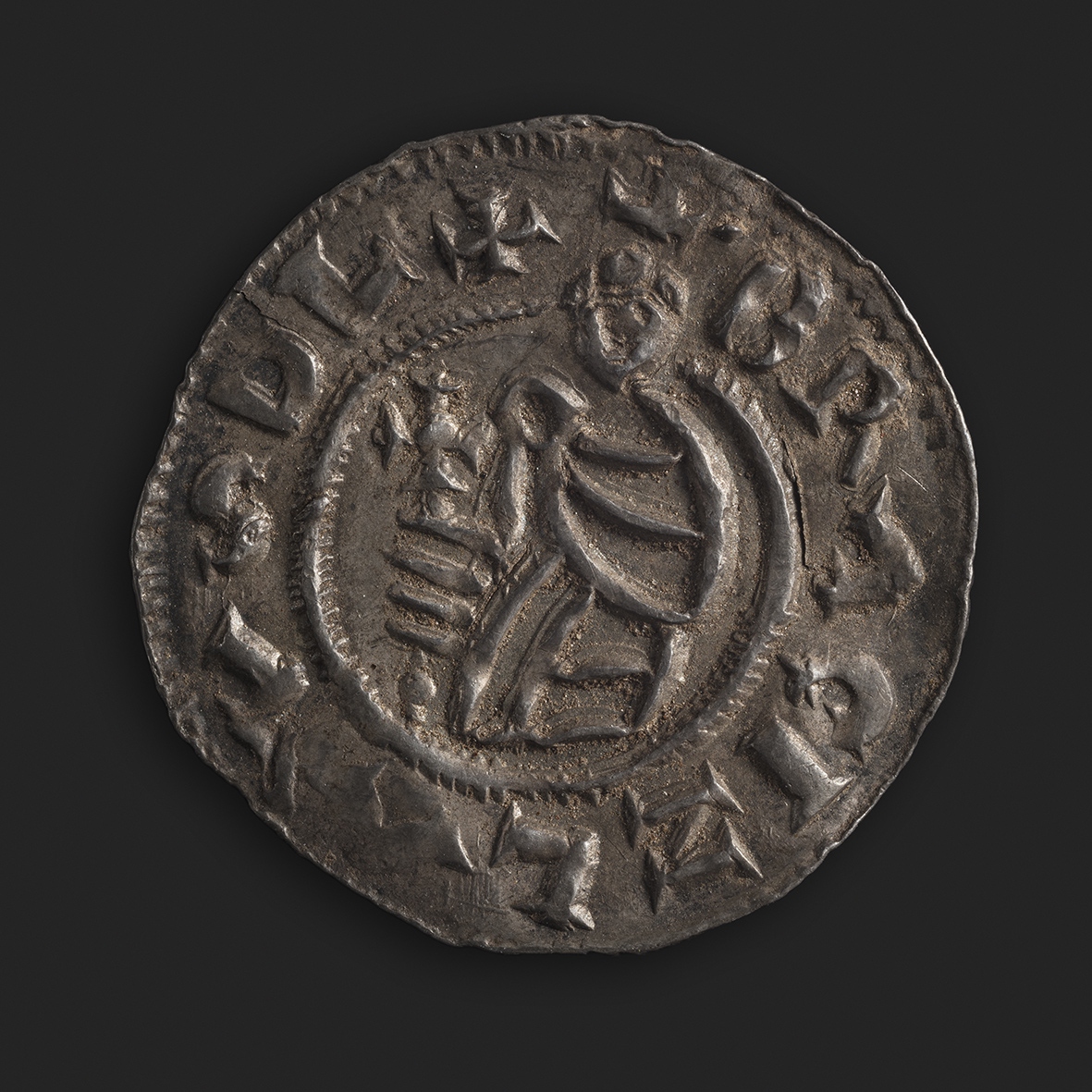
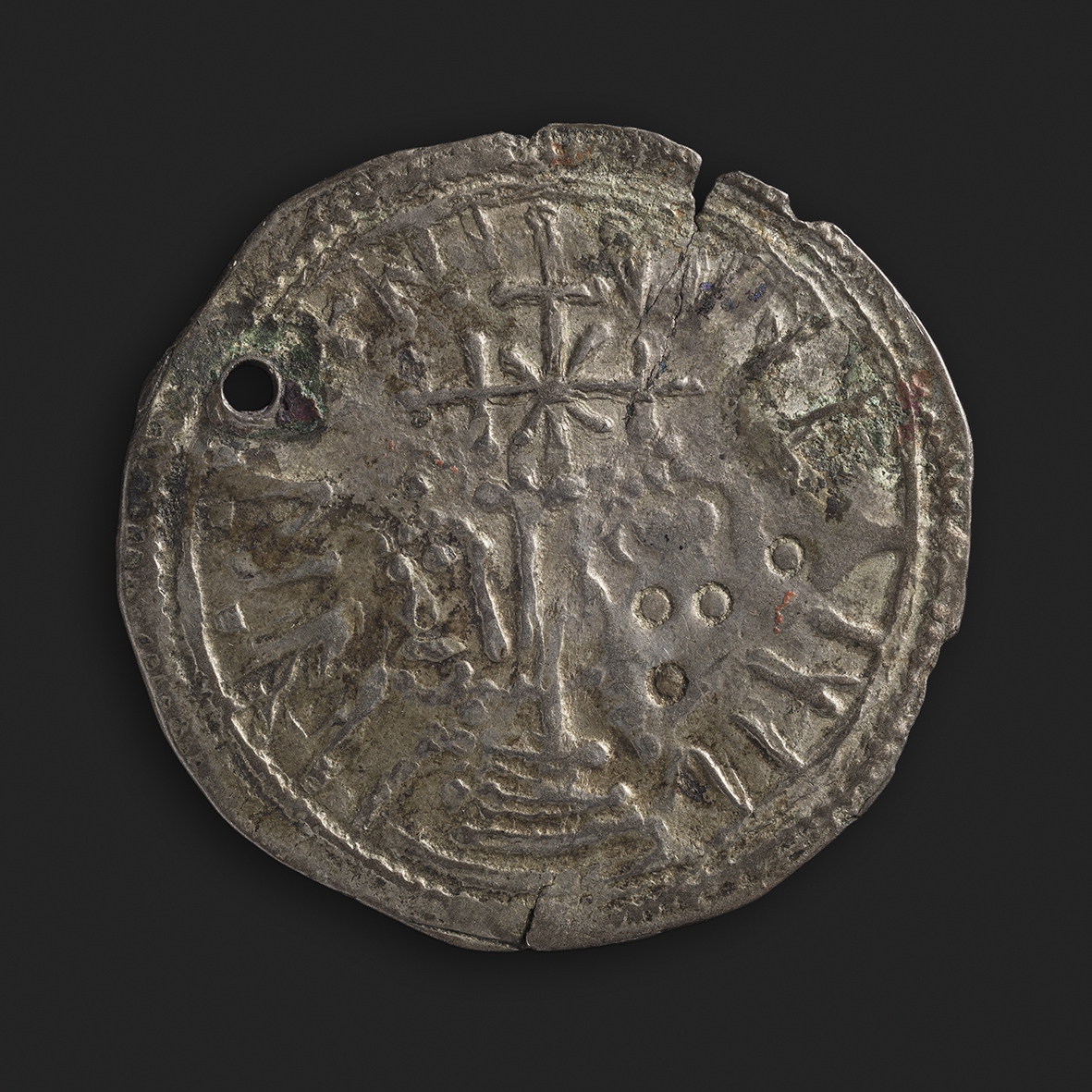
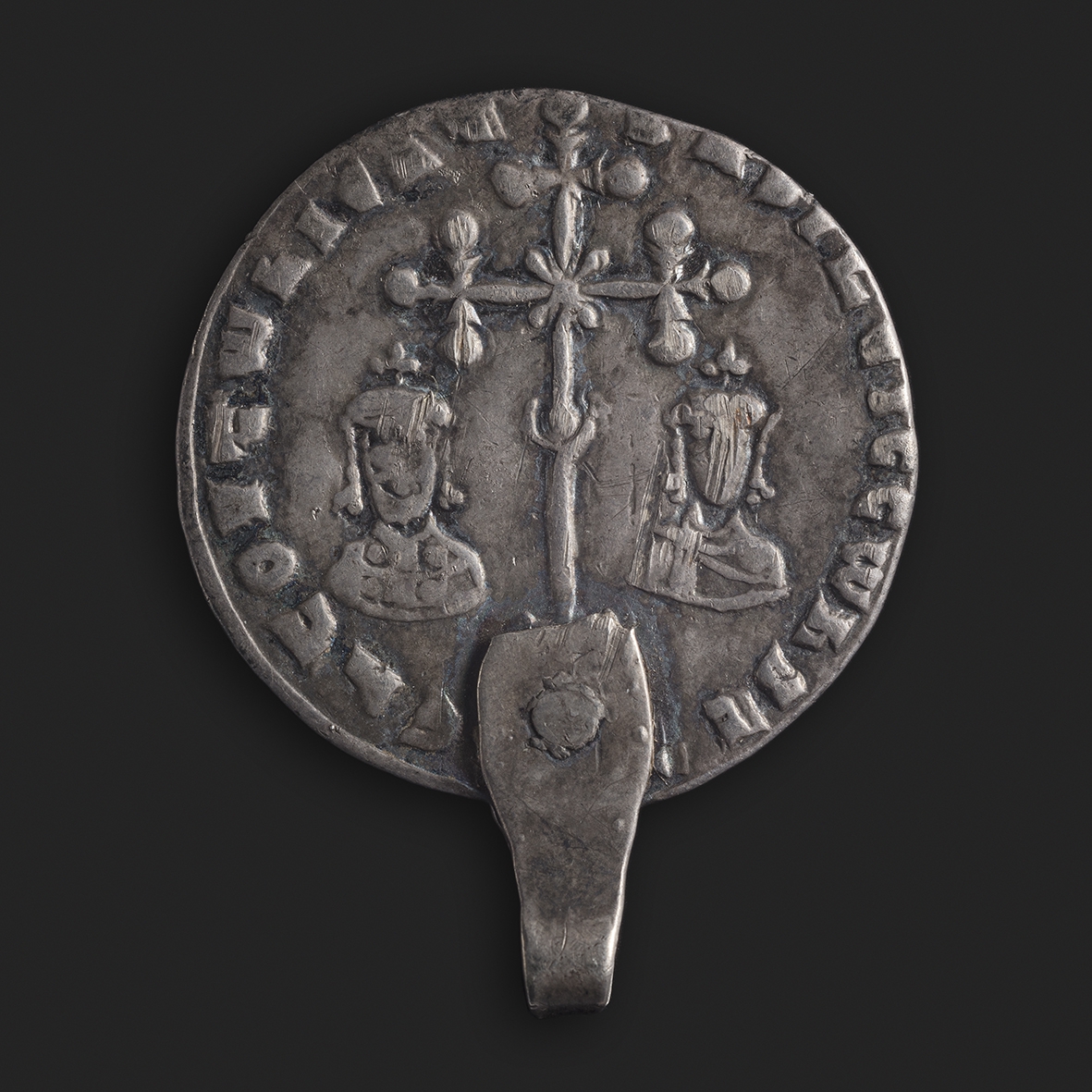
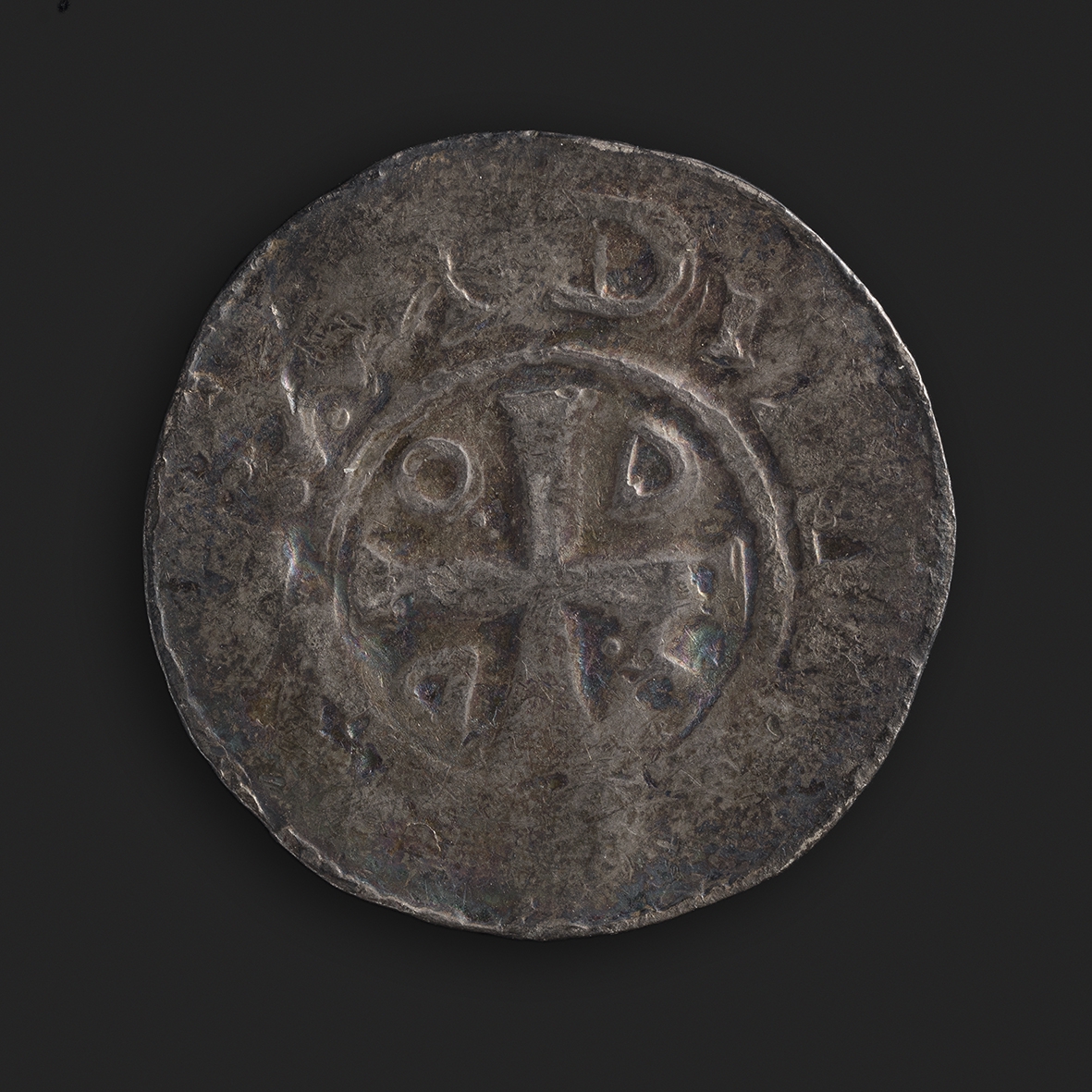
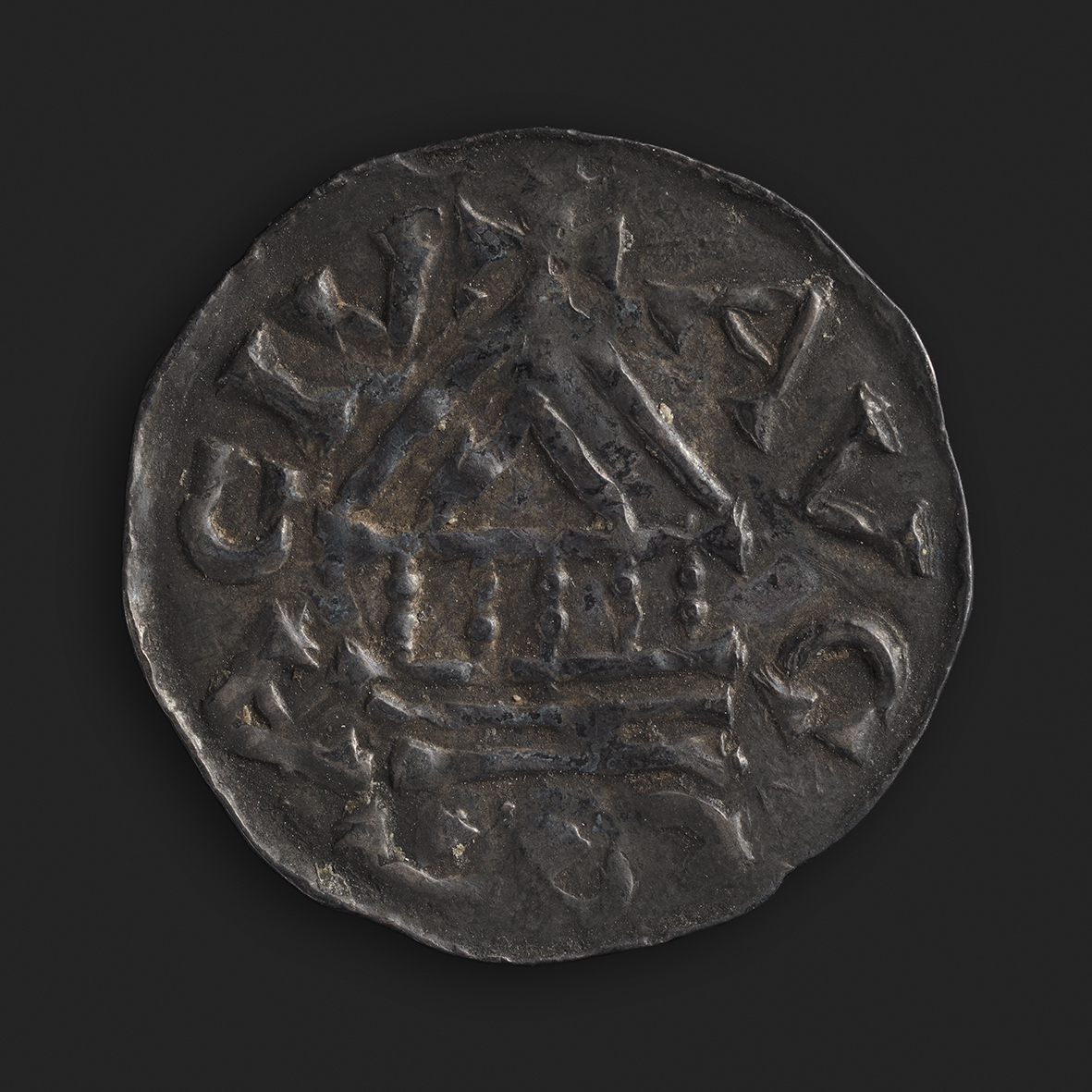
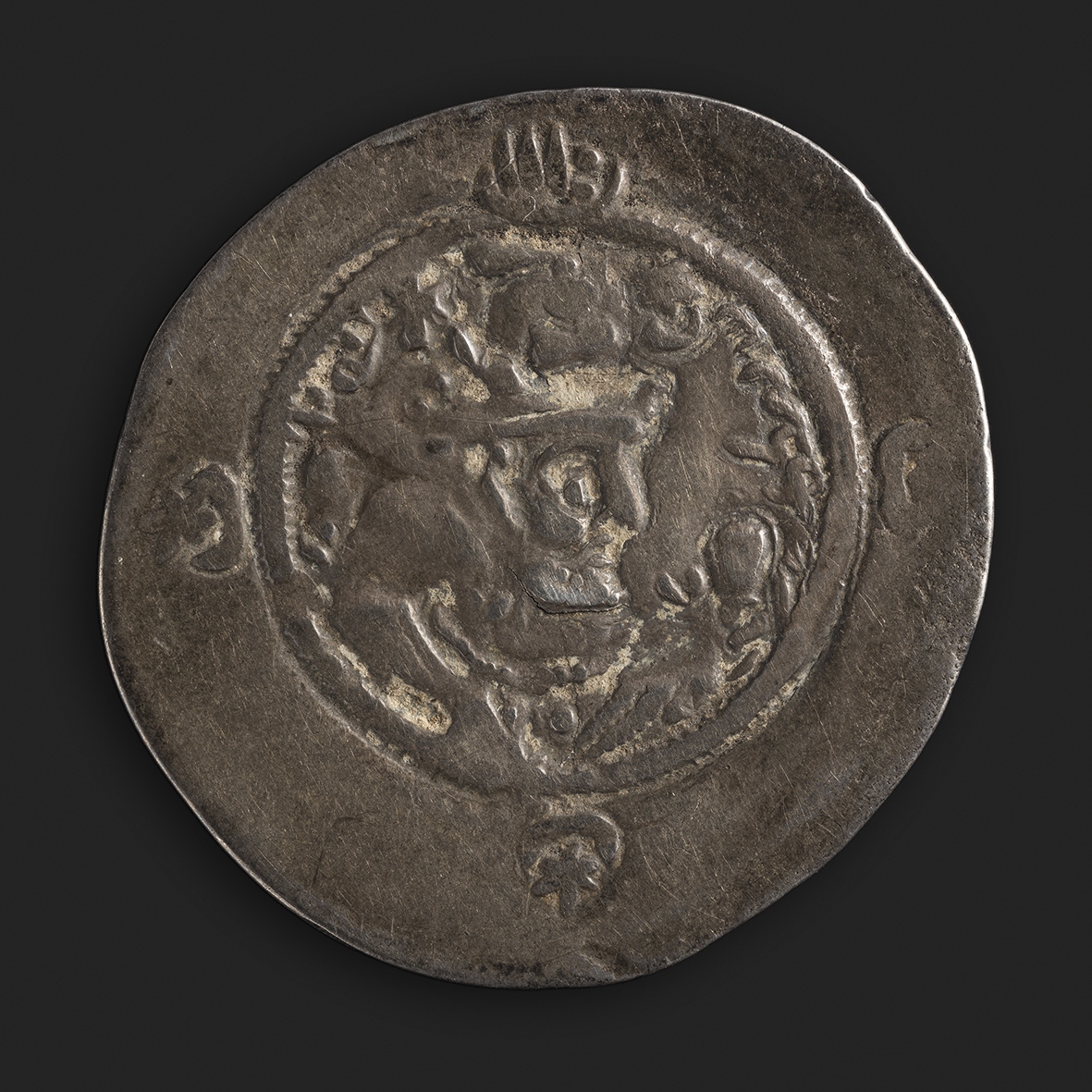
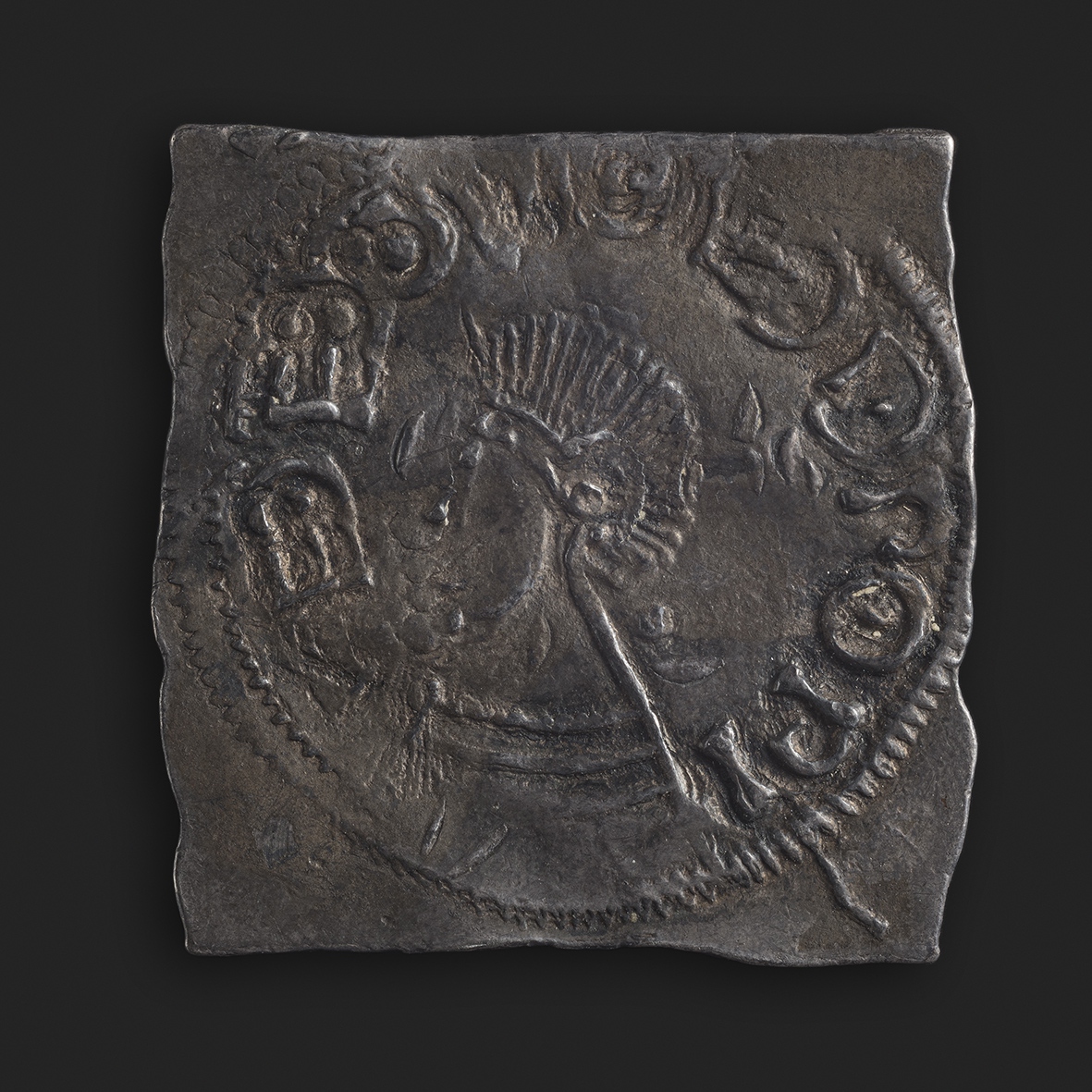
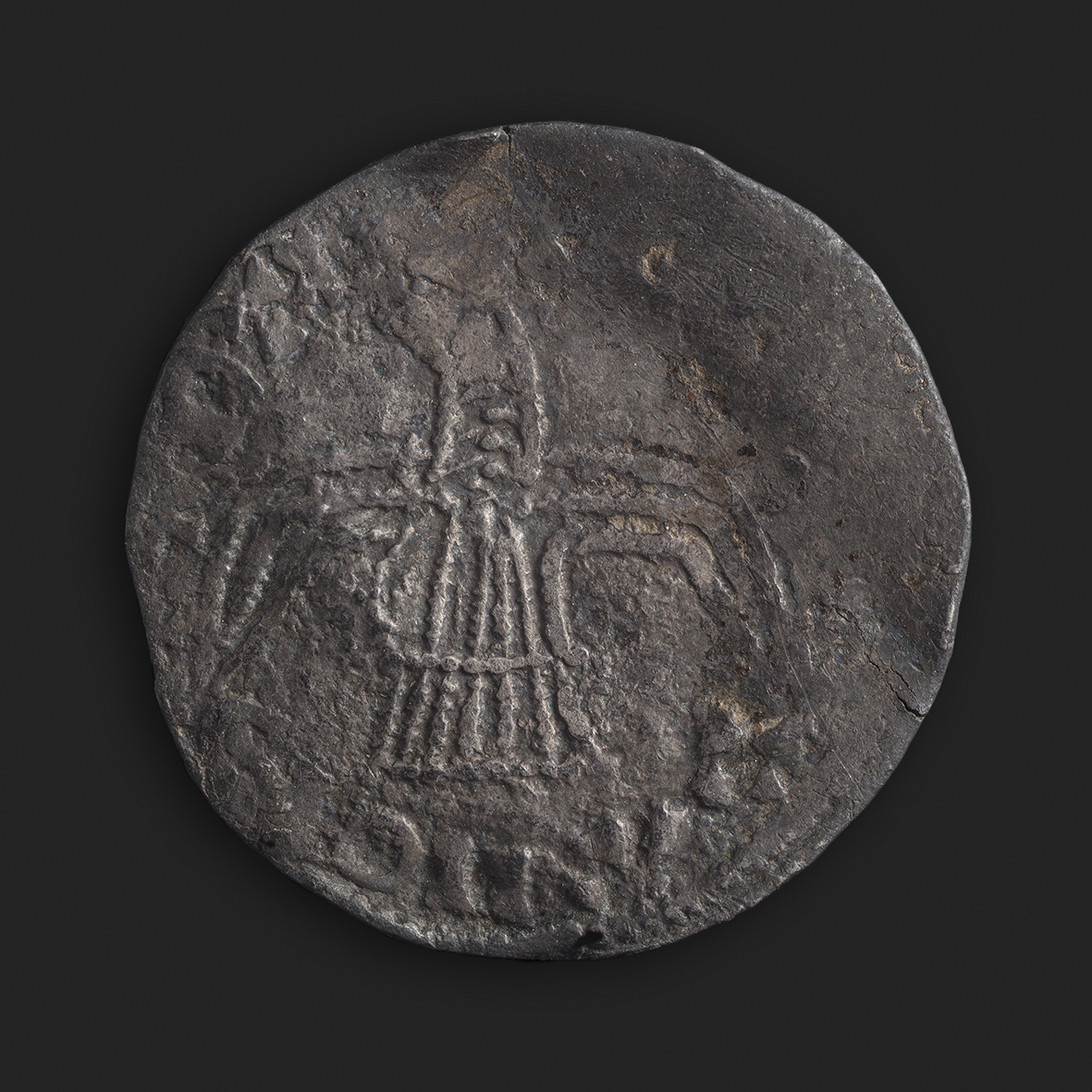
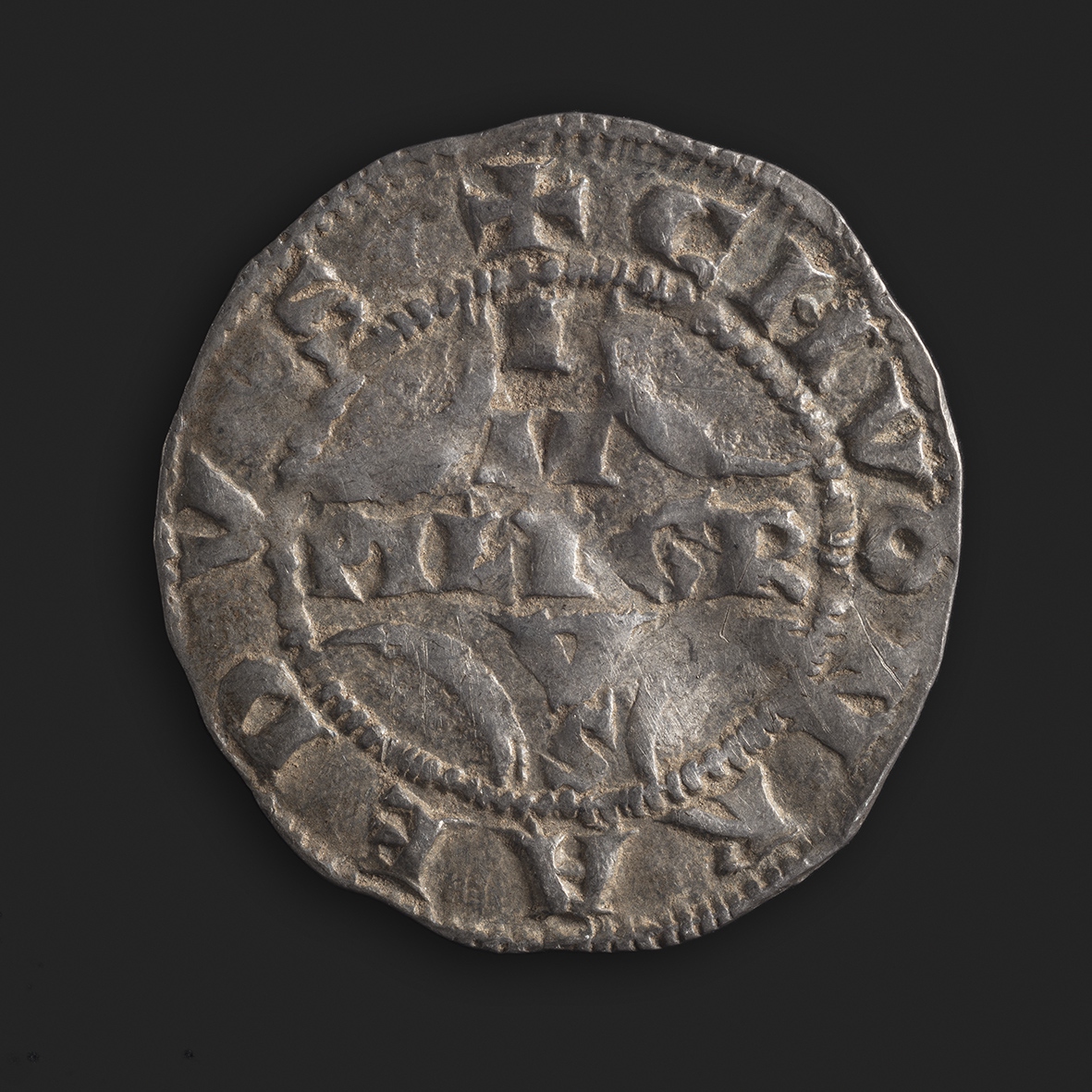
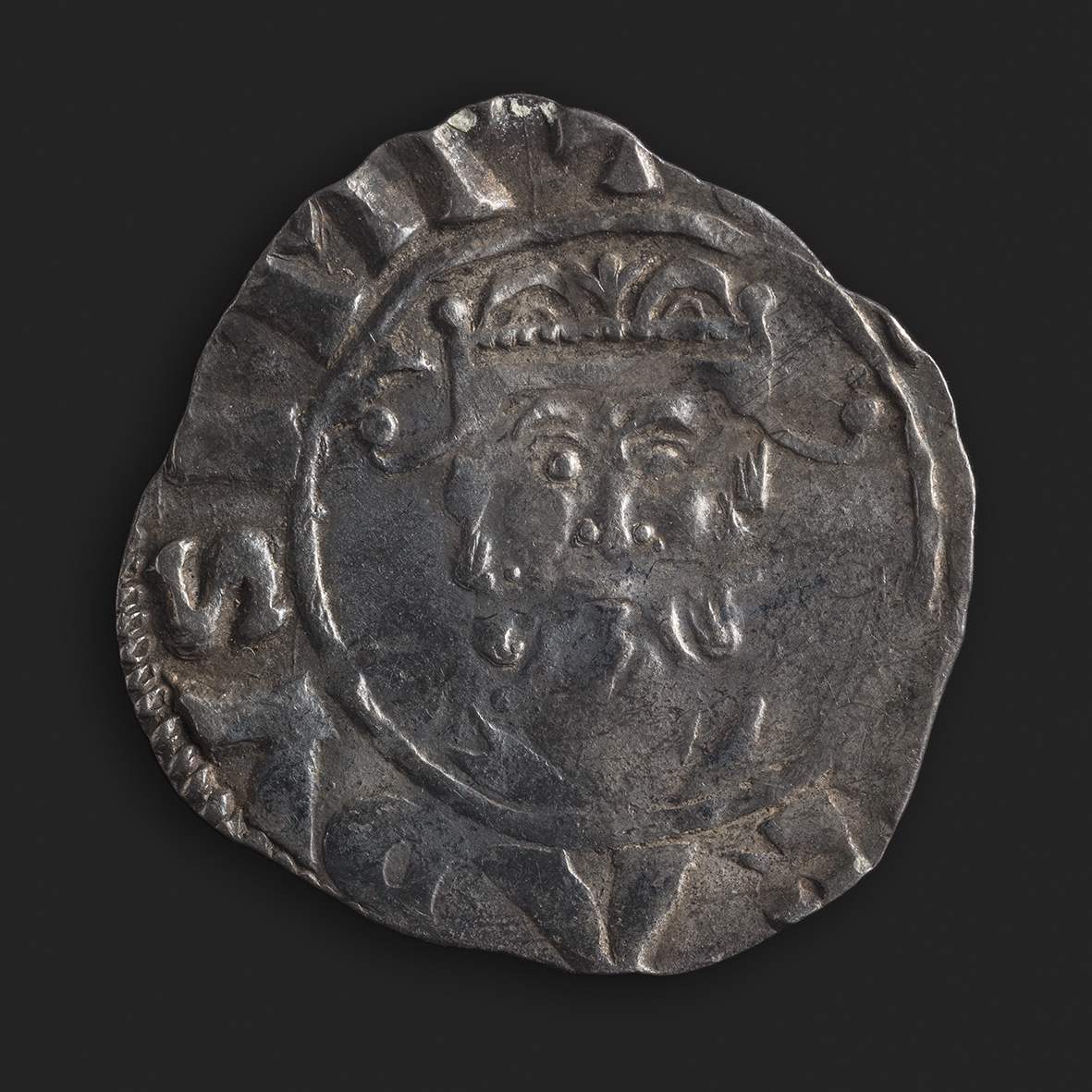
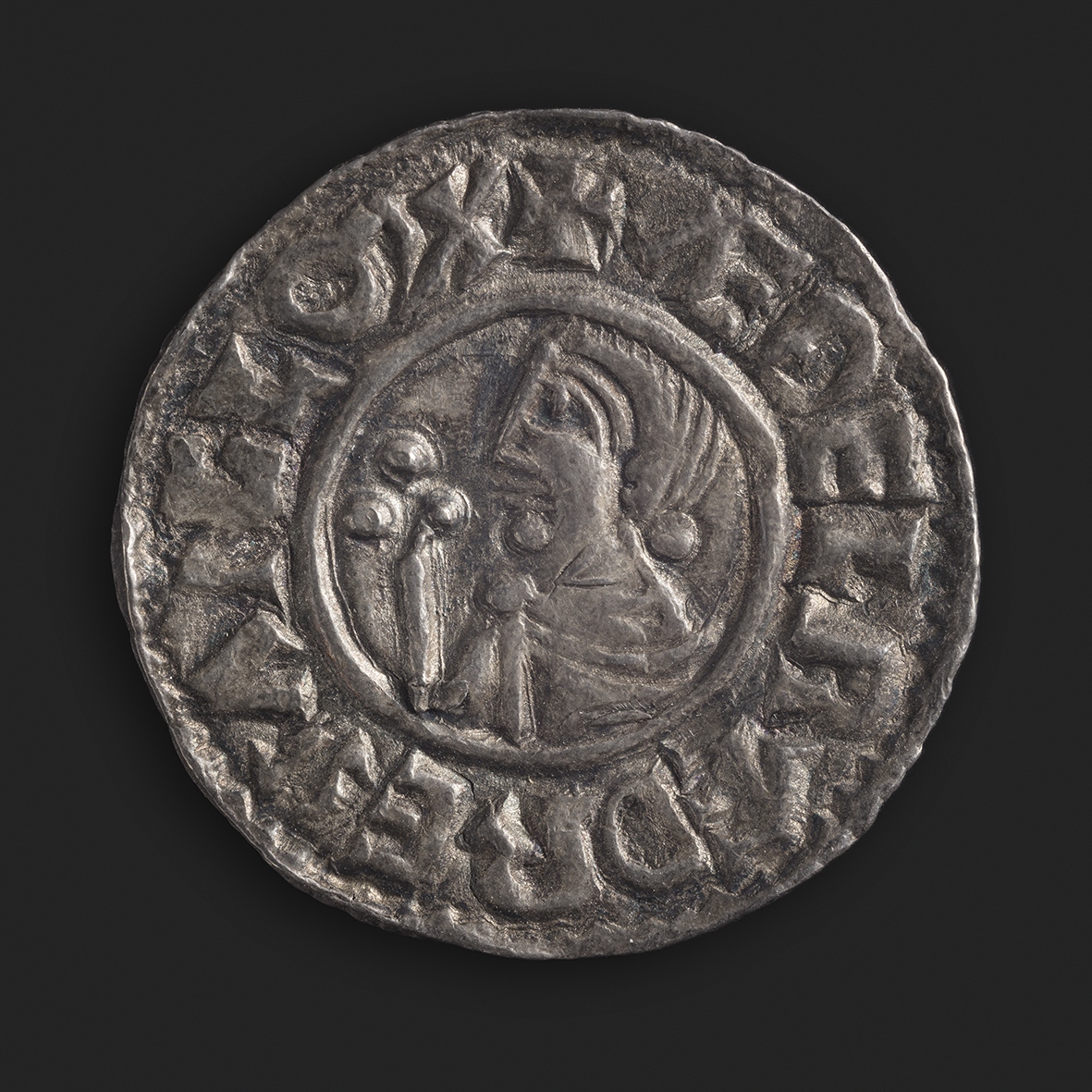
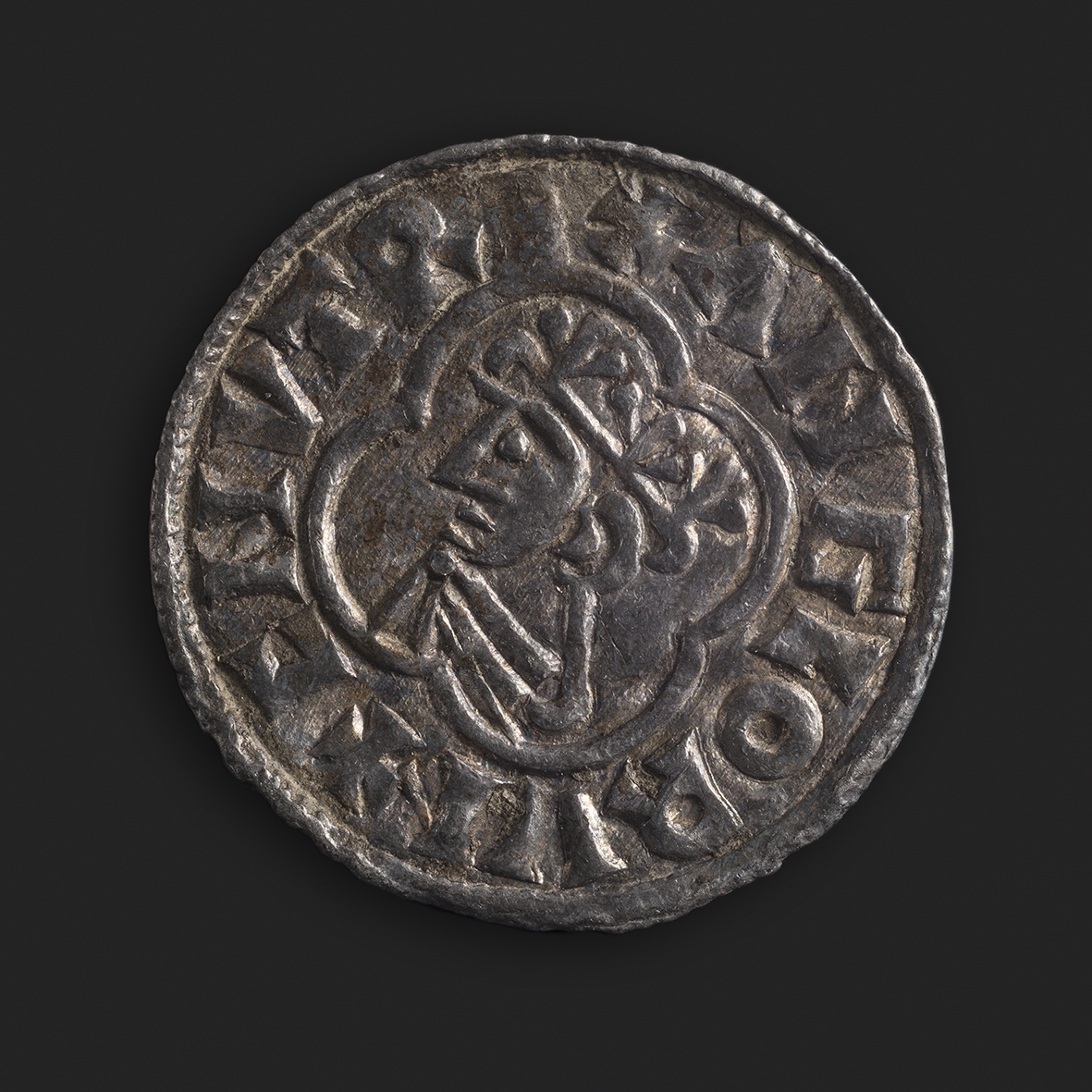
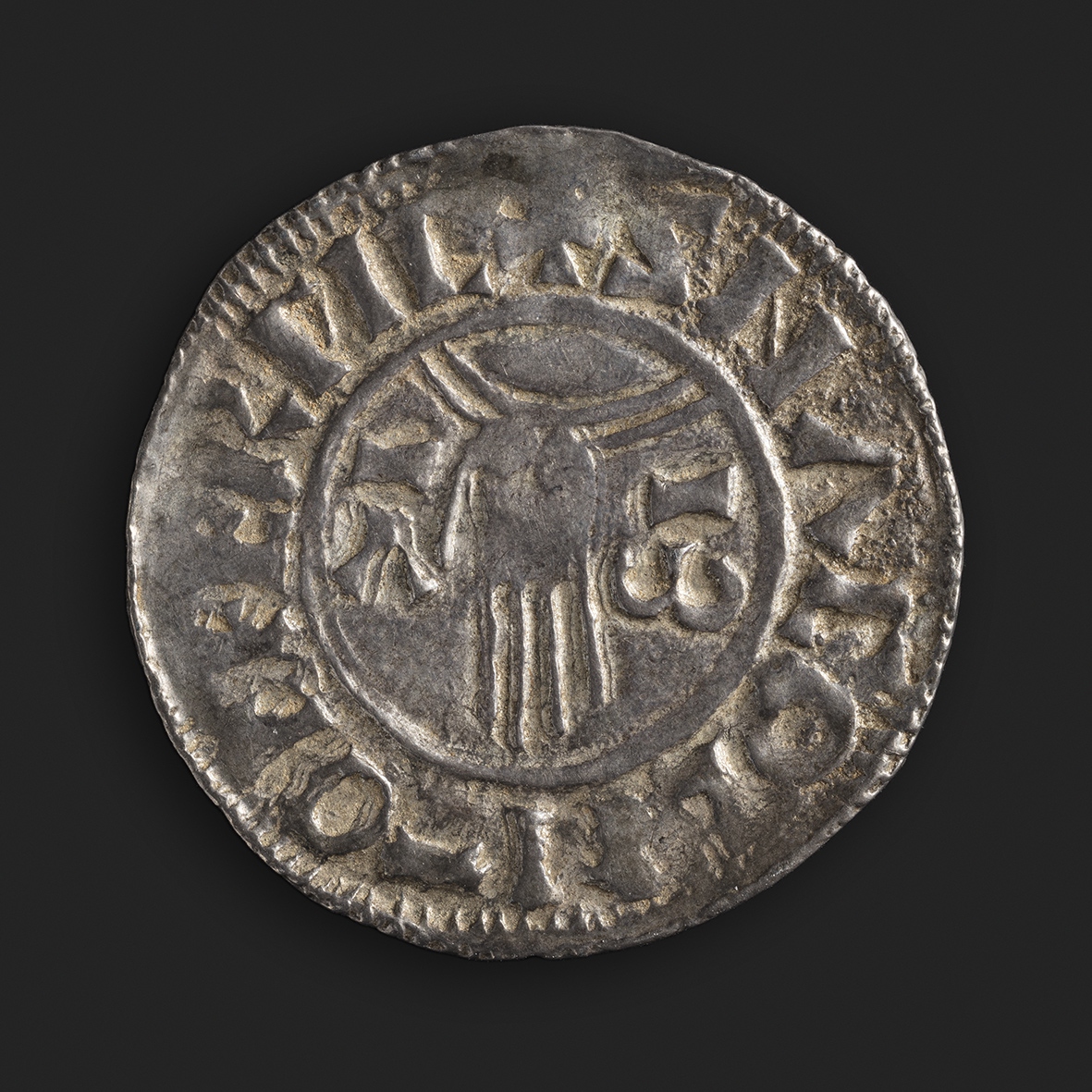
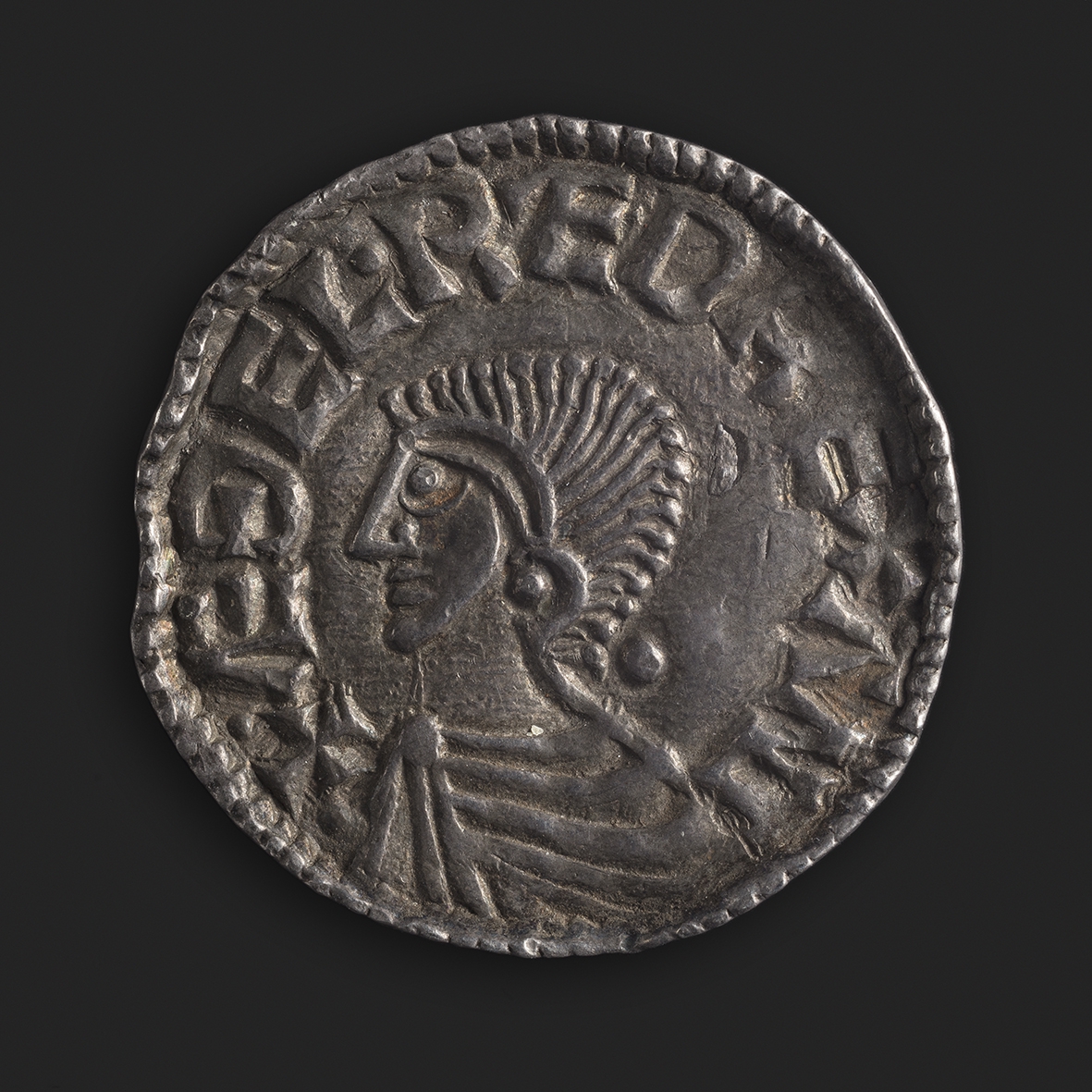
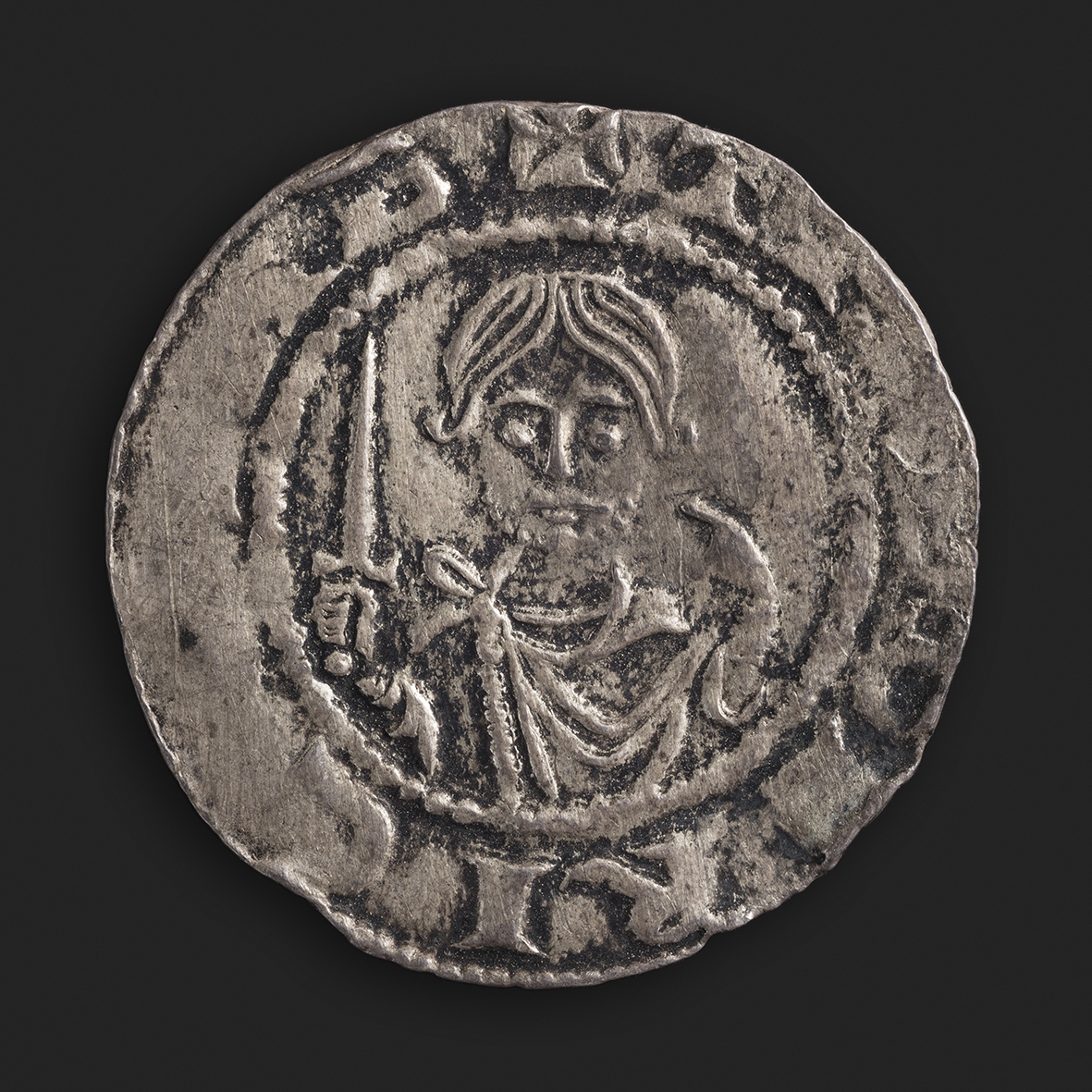
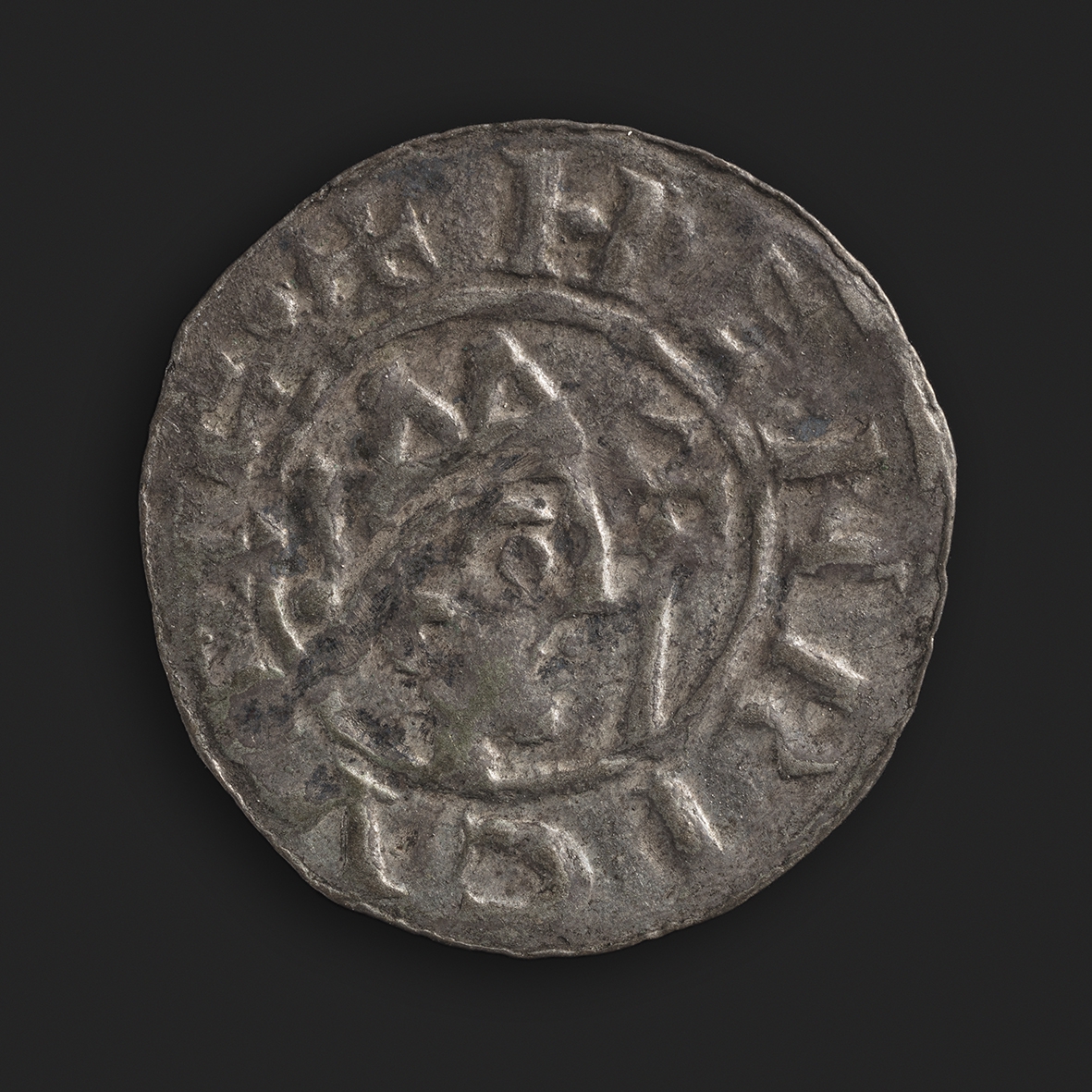
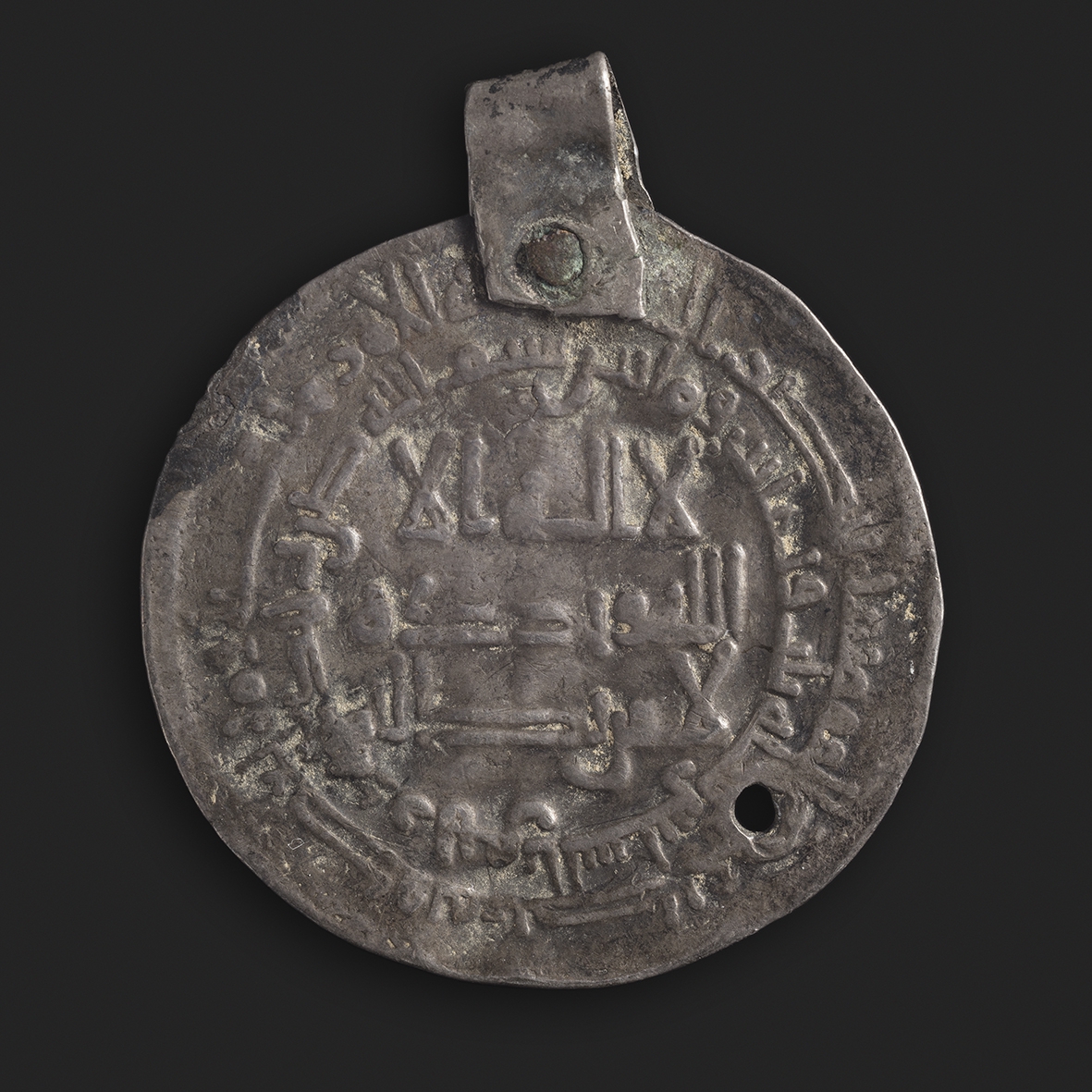
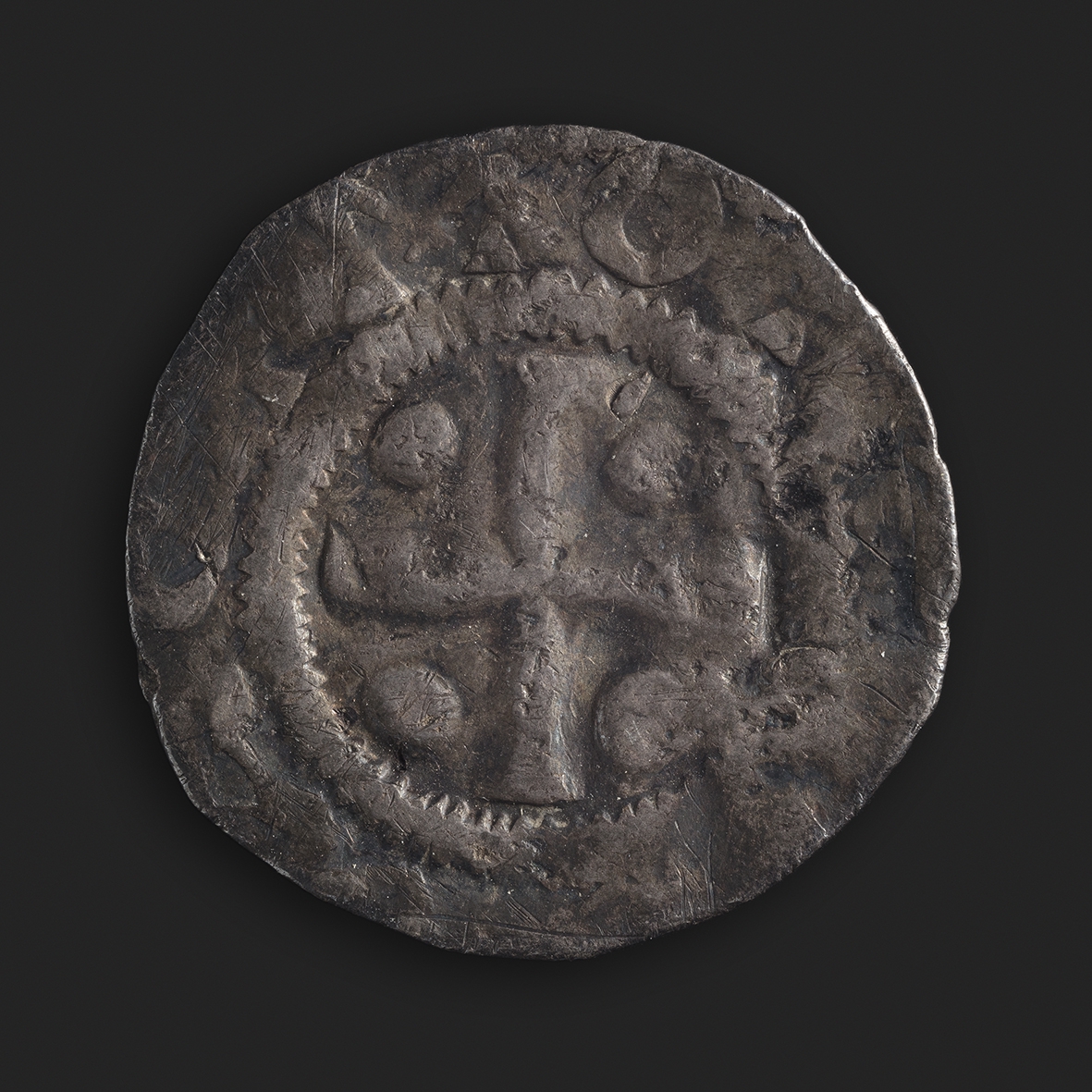
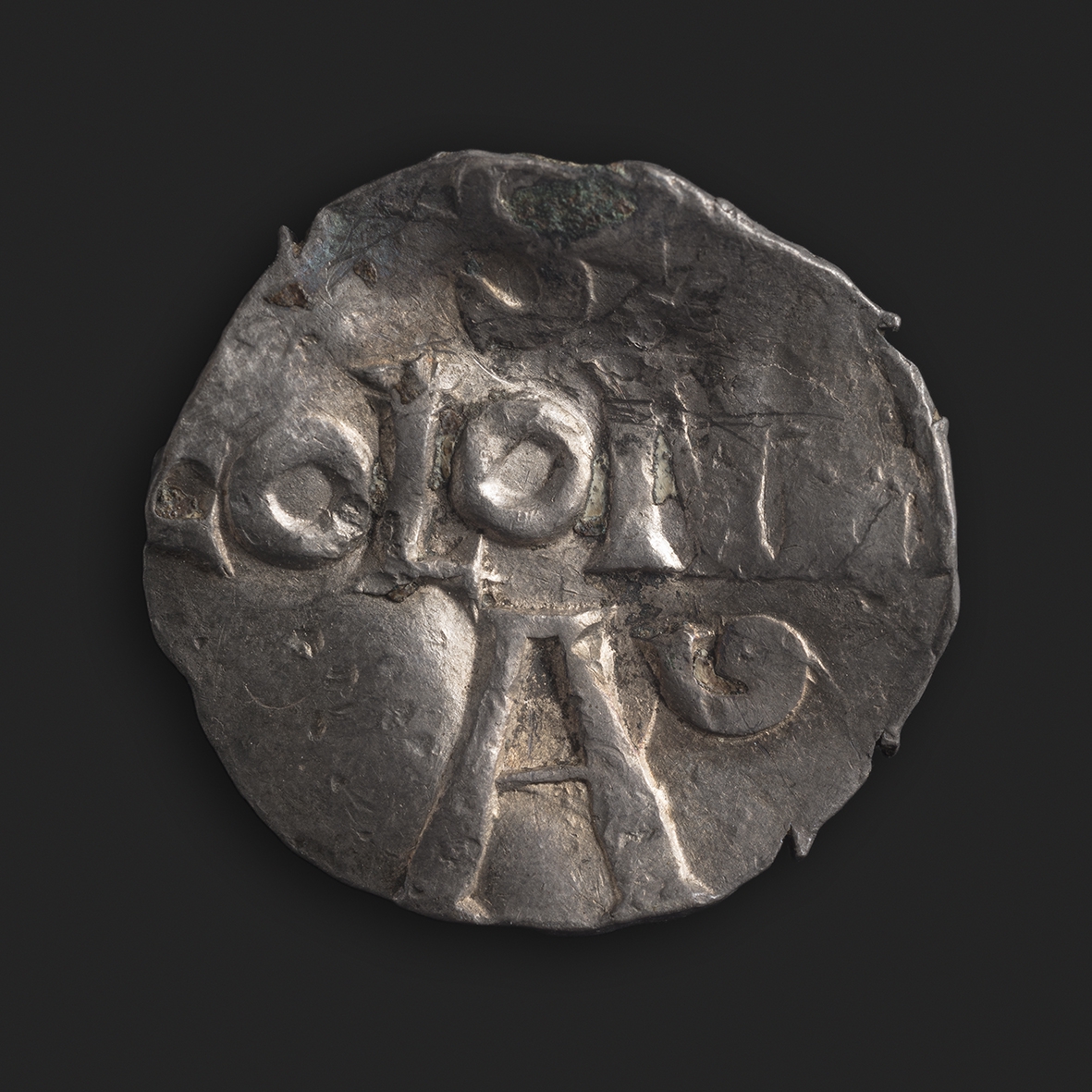
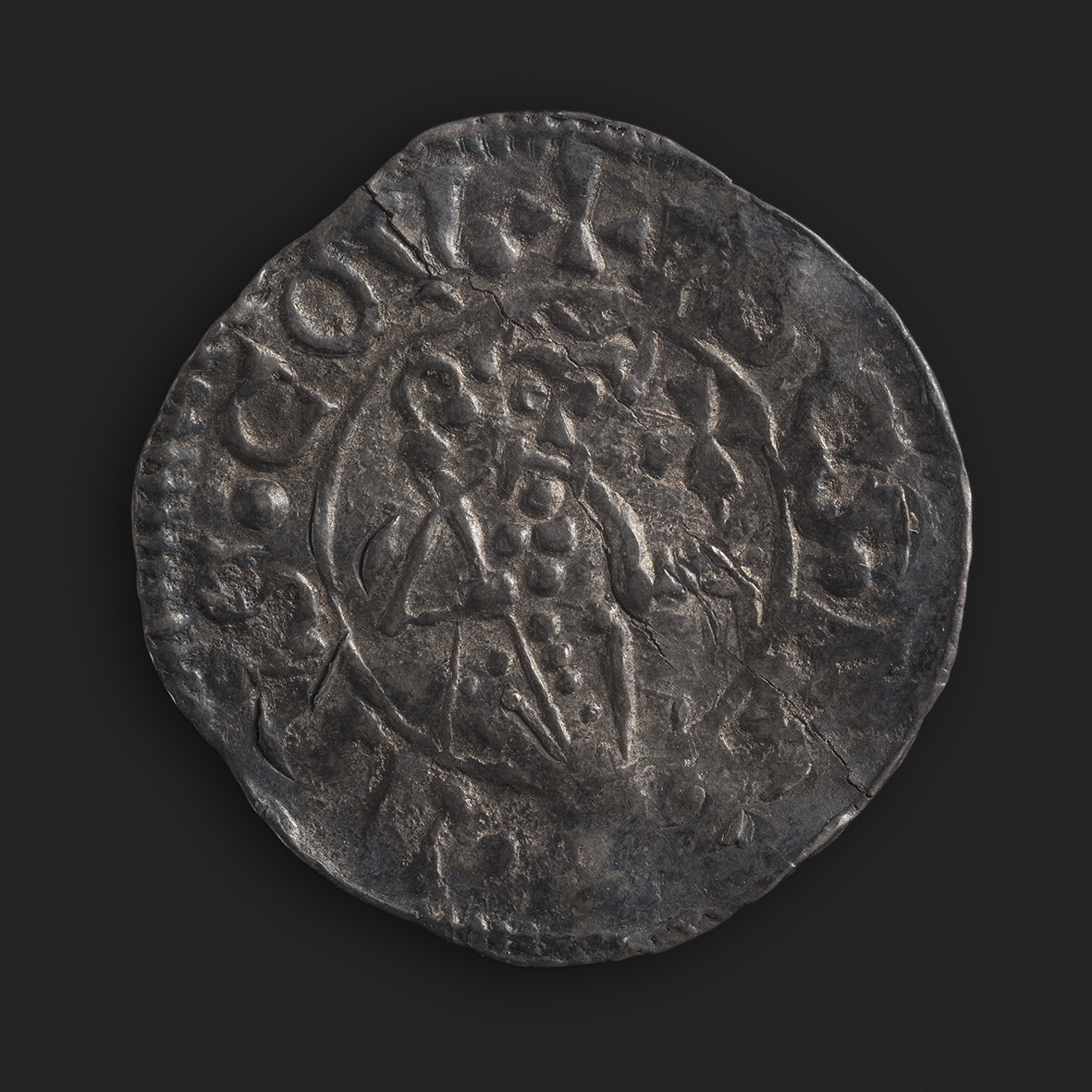
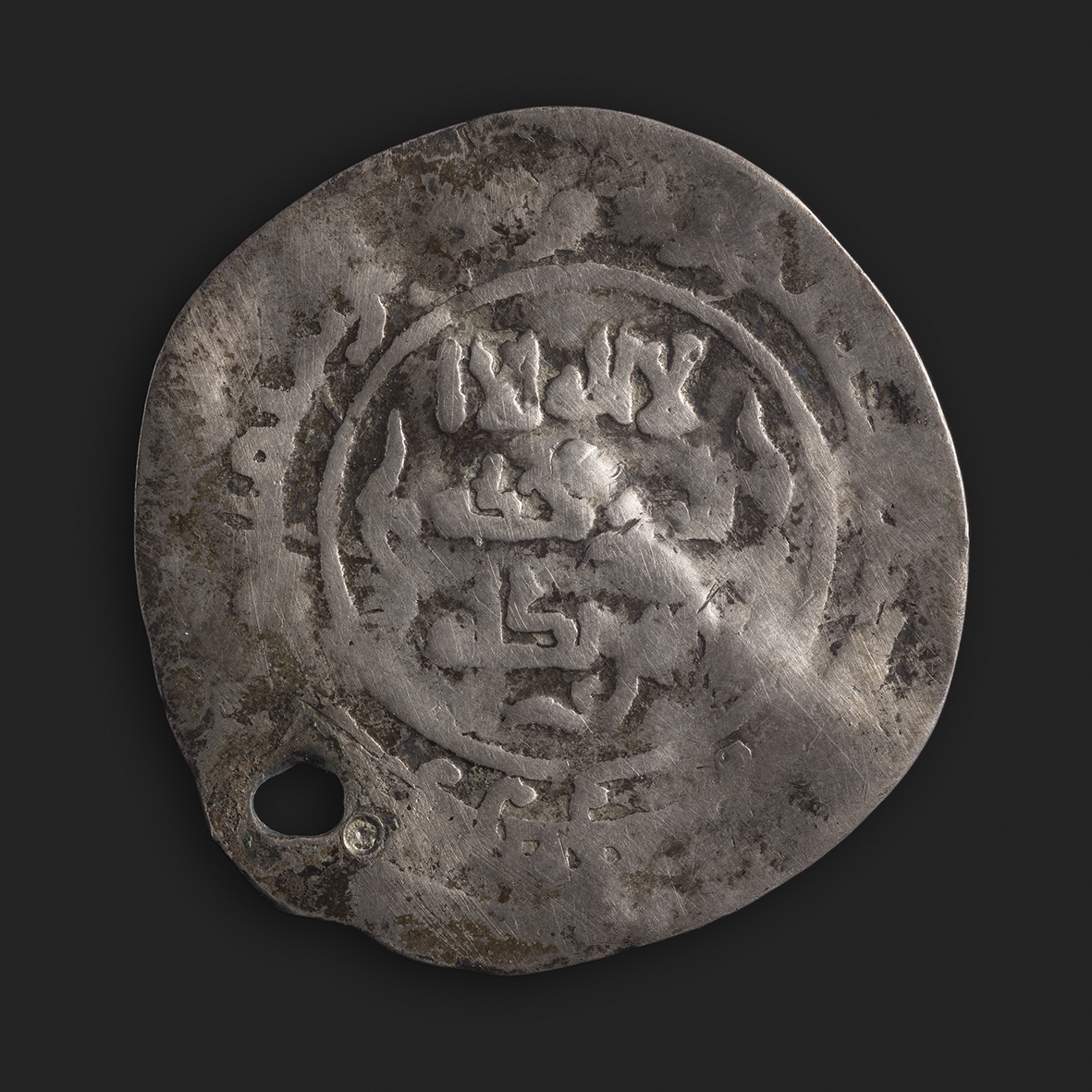
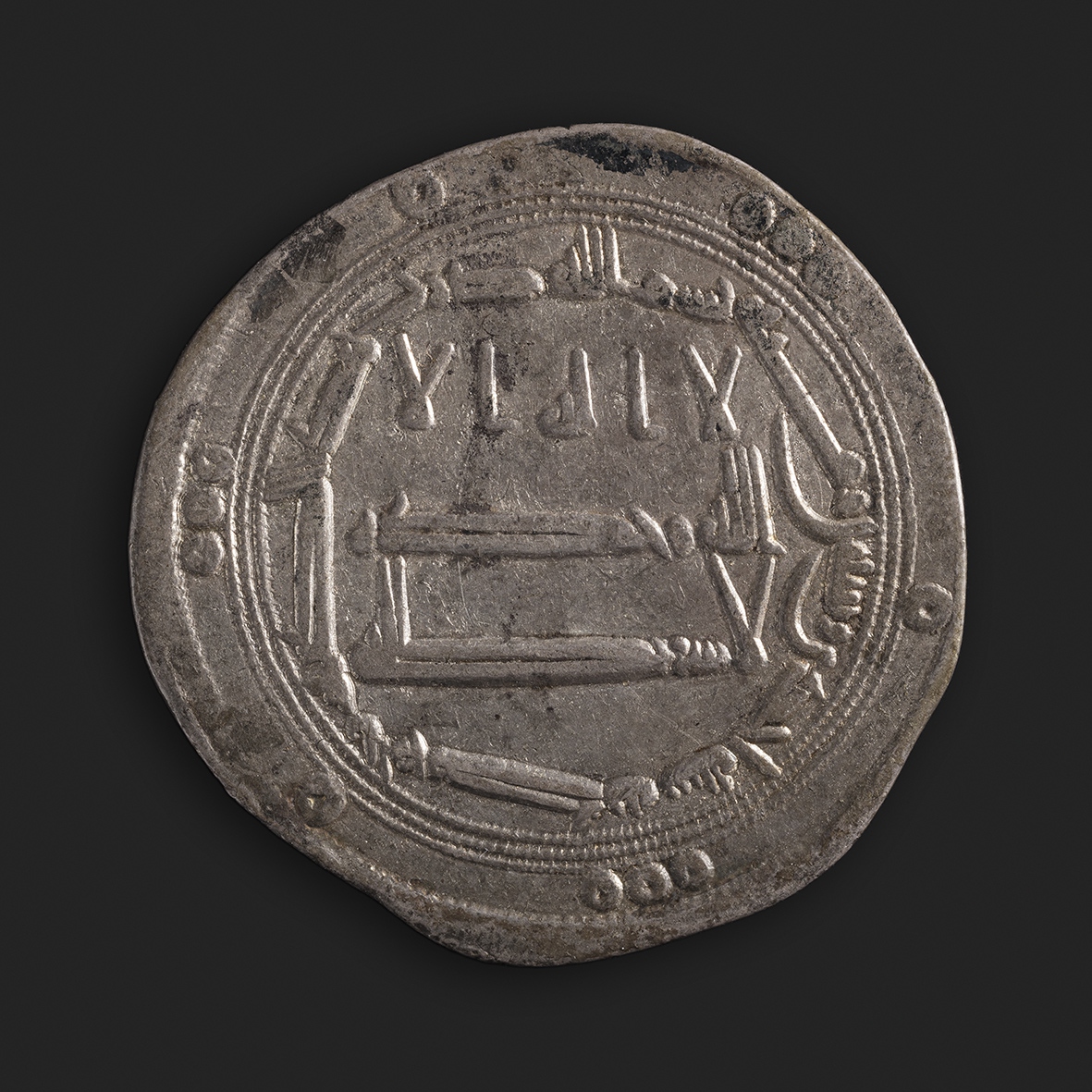
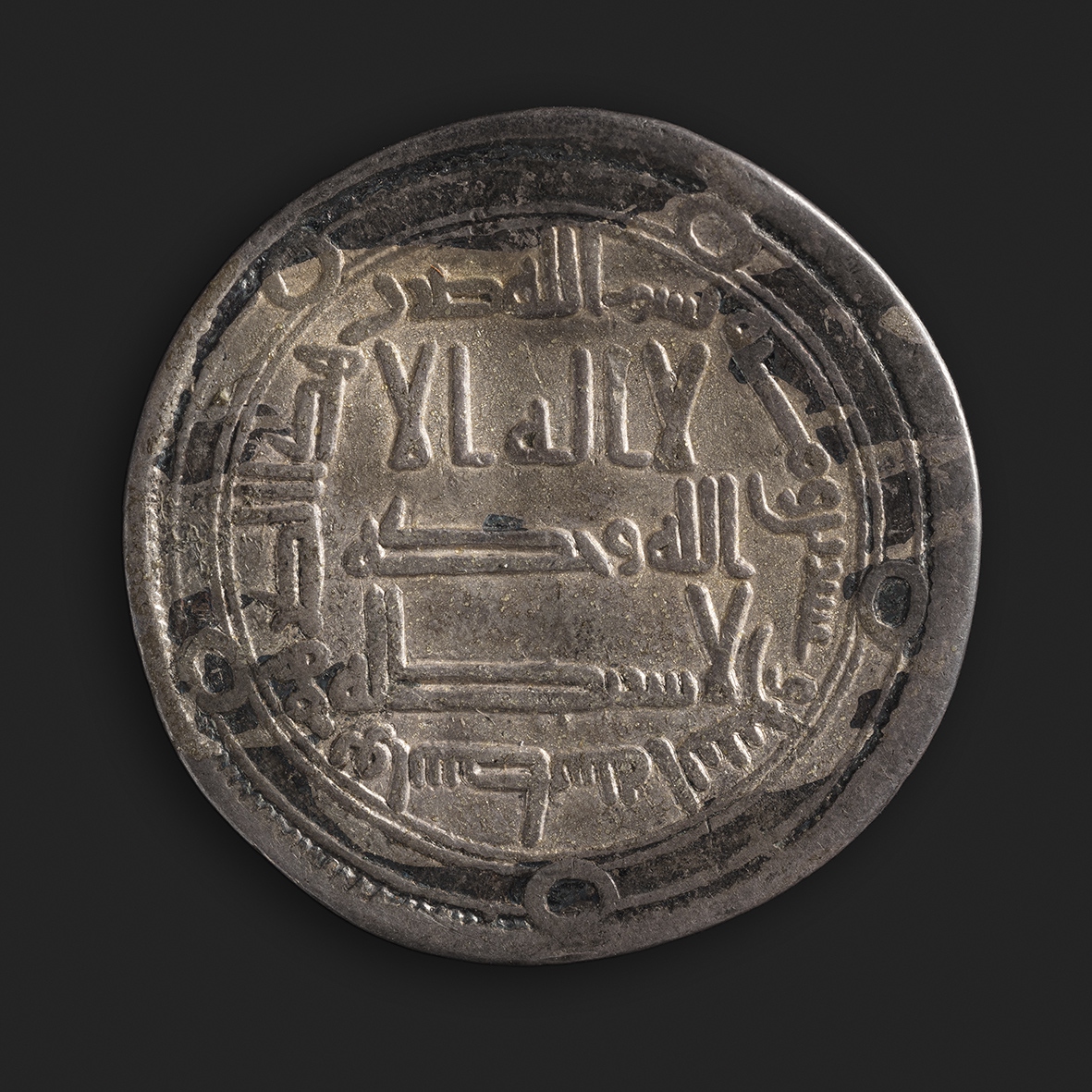
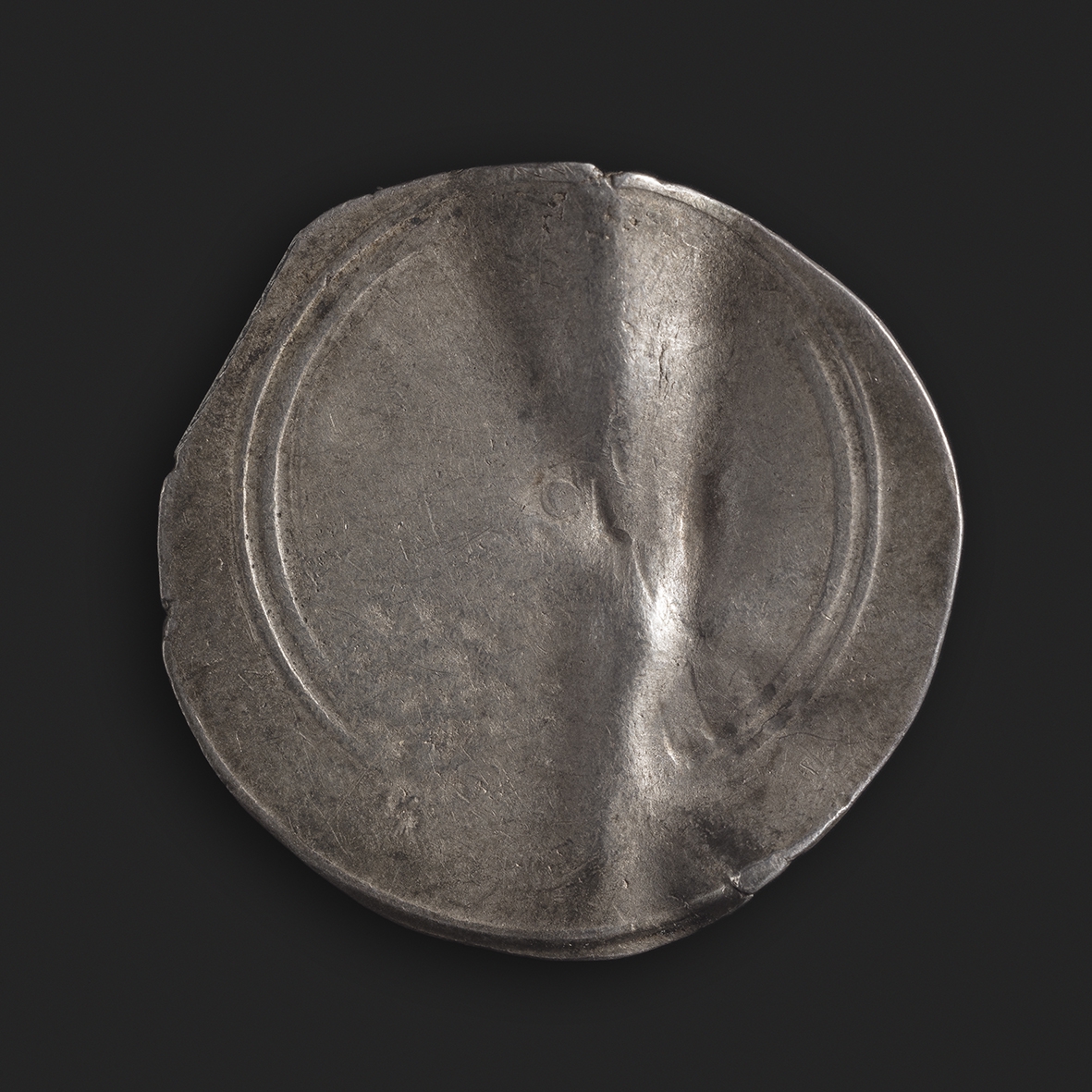
Bohemian penny of Bretislav I
Imitation of a Byzantine miliaresion of Basil II and Constantine VIII
Byzantine miliaresion used as a pendant
German Otto Adelheid penny
German penny from Augsburg
Drachma of the Sasanian Dynasty
Anglo-Scandinavian imitation of an English penny
Penny of Cnut the Great from Lund
Penny of Archbishop Pilgrim of Cologne
Penny of Emperor Conrad II
English penny from Barnstaple
Penny of Cnut the Great from Lincoln
English penny from York
English penny from London
German penny from Gittelde
German penny from Dokkum
Samanid dirham
Penny of Otto III from Mainz
Penny of Otto III from Cologne
German penny from Utrecht
Dirham imitation from Volga Bulgaria
Abbasid dirham
Umayyad dirham
Incomplete dirham

Bohemian penny of Bretislav I
A Bohemian penny of Bretislav I, Duke of the Přemyslid dynasty (dated 1034–1055). On the front of the coin is a picture of the ruler wearing a cloak tied to his right shoulder. He is holding a cross-staff in his right hand. On the back is a bird that has spread its wings. The perimeter text SCS VVENCESLAVS refers to Saint Wenceslaus, Duke of Bohemia, who was murdered and later rose from martyrdom to sainthood.
Bohemian coins have rarely been found in Finland. The coin presented here was found in Sääksmäki, Valkeakoski, in 1929 or 1930 in a Viking Age hoard that contained an estimated 600 coins. The unknown finder sold the contents of the hoard to a goldsmith in Hämeenlinna, who in turn distributed the coins to various parties. There are only 42 coins known from the hoard, which had been hidden sometime after 1006.

Digital collection

Imitation of a Byzantine miliaresion of Basil II and Constantine VIII
This coin is an imitation of a Byzantine miliaresion of Basil II and Constantine VIII, possibly produced in the region of Finland. These imitations are mainly known from finds in Finland, some also from Estonia. Individual pieces have also been found in Sweden and Denmark. The Byzantine imitations found in Finland mainly imitated the coins of Basil II and Constantine VIII. Basil II ruled the Byzantine Empire with his brother Constantine VIII until his death (in 976–1025). Struck on one side only, the front face of the coin features a cross, on the left of which an attempt has been made to reproduce the crowned and bearded figure of Basil II, with the bust of his brother Constantine VIII, wearing a cloak, on the right. In addition, there are four dots on the coin that may have been made later, possibly when the hole was punched. The coin was worn as jewellery.
This imitation was found on a farm in Turenki in 1832, in addition to a few silver objects and Viking Age coins and another Byzantine imitation. The objects had been hidden in or after the 12th century. The coins were mixed with other hoard finds in the coin and medal collection of the University of Helsinki in the 19th century. This imitation is one of the two coins that can certainly be linked to the hoard found in Turenki, Janakkala.

Digital collection

Byzantine miliaresion used as a pendant
A Byzantine silver coin, miliaresion, of Basil II and his brother Constantine VIII, struck in Constantinople (977–989). On the front of the coin is a cross, on the left side of which is a crowned and bearded Basil II in a gem-decorated outfit, and on the right side a crowned Constantine VIII wearing a cloak. On the back, there is text (the names of the two rulers). Basil II was the Byzantine Emperor and ruled the empire with his brother until his death in 1025. The coin was used as a pendant, and both the loop and the rivet used for fastening have been preserved well. Byzantine coins are rare in the Finnish find material, and most of them are perforated, which suggests that miliaresions have mainly been used here as jewellery.
The coin was found in a hoard in Anttila, Lieto, in 1897. Some 900 Viking Age coins and a few pieces of jewellery had been hidden inside a clay vessel. Most of the coins (more than 700 coins) were German pennies, but there were also several English coins and some Danish, Islamic and Irish coins, for example. The objects had been hidden sometime after 1060.

Digital collection

German Otto Adelheid penny
This coin is a German Otto Adelheid penny found in a Viking Age hoard in Tuomola, Raisio, in 1835. The coin was struck in the name of King Otto III, who came to power as a minor, and his regent, his grandmother Adelaide (dated 983–1002). On the front of the coin is a cross with the letters O-D-O-D in the corners. On the back is a wooden church with a dot inside it and a horizontal bar at the bottom. Otto Adelheid pennies were struck in Saxony, and they are the most common type of Viking Age coins found in Finland and Sweden. Otto Adelheid pennies were produced in huge numbers in various mints, and the main minting location was probably Goslar. Some of the coins may have also been struck in Quedlinburg and Hildesheim. Otto Adelheid pennies were later imitated until around 1050. The objects found in the hoard in Tuomola, Raisio had been hidden sometime after the mid-11th century.

Digital collection

German penny from Augsburg
A penny struck in Augsburg, present-day Germany, in the Bavarian region. The coin was struck by Eberhard (Eppo) I, who served as the bishop of Augsburg from 1029 to 1047, together with Emperor Conrad II. On the front of the coin is a cross with a single dot at the end of each arm and the letters K-V-O-И at the corners, which refer to Conrad II, Emperor of the Holy Roman Empire of Germany from 1024 to 1039. On the back is a picture of a five-column church.
The coin was included in a hoard found in Kuuppala, Kurkijoki, in 1866 during the demolition of an old shed. Most of the coins were sold, but some ended up in the collections of the University of Helsinki and later in the National Museum’s Coin Cabinet collection. It has been estimated that the hoard included several hundred coins, about 50 of which are known. The coins had been hidden sometime after ca. 1050.

Digital collection

Drachma of the Sasanian Dynasty
Persian silver coins from the Sasanian Dynasty (ca. 224–650 CE) are called drachmas. These coins can often be easily dated since they carry information about the mint and the year of minting according to the reign of the ruler. In the region of Finland, only a few drachmas have been found in Åland. The hoards that contained the drachmas can be dated to ca. the 9th century and the drachmas themselves to ca. 559–625. They were struck by the rulers Khosrow I, Khosrow II or Hormizd IV.
The coin presented here is a drachma of Hormizd IV, struck in Kas Ahmadan in Persia (present-day Iran) in the fourth year of the ruler’s reign (582 CE). On the front of the coin is a portrait of the ruler, and the back face features the Zoroastrian holy fire, Atar, in the middle with priests on both sides. In addition, the name of the mint is mentioned on the right and the year of minting on the left.
The drachma was included in a hoard found in 1915 in Geta (Svedjelandet), Åland, which contained more than 100 coins. There were at least 14 drachmas and 93 Islamic dirhams in the hoard. The coins had been hidden sometime after 837.

Digital collection

Anglo-Scandinavian imitation of an English penny
An imitation of an English Long Cross penny found in Sievola, Paimio, in 1841. On the front of the square planchet is a profile of a king facing left, and the back shows a long double cross reaching the inscription.
Anglo-Scandinavian coins imitate English pennies, and they were struck in Sigtuna and Lund, for example. The Long Cross coin presented here may have been struck in Sigtuna, as the special characteristics of the mint included striking coins into square planchets. Anglo-Scandinavian pennies did not necessarily have a monetary value outside the region in which they were struck or its vicinity, but the value was based on the weight of silver. The Long Cross penny was the most commonly copied English model, and its copying continued for a long time after the original penny was no longer made.
The hoard in Sievola, Paimio contained at least 200 coins, which had been hidden sometime after ca. 1030. Today, however, only 27 coins are known that can be linked to this hoard. The person who found the hoard sold the coins to a goldsmith, from whom some of the coins were purchased by collectors and later ended up in the National Museum’s Coin Cabinet collection as part of the coin and medal collection of the University of Helsinki.

Digital collection

Penny of Cnut the Great from Lund
A Danish penny struck in Lund (dated 1018–1035). The coin was struck by King Cnut the Great of England, Norway and Denmark. On the front of the coin is a cross and on the back a dove, symbolising the Holy Spirit. When he was crowned King of Denmark in 1018, Cnut the Great also started to strike coins in the region of Denmark, using English pennies as a model. Cnut the Great is considered to be the founder of the Danish monetary system since he was the first to start systematically striking coins in the region. In Denmark, Lund was the most important minting location, and most of the Danish pennies found in Finland were made in Lund.
This coin was included in a hoard found in 1895 in Nikkilä, Nousiainen, which contained more than 1,600 coins and some silverware. A significant number of the coins in the hoard were German pennies, of which more than 1,100 were found, but there were also many English and Scandinavian coins as well as some Italian, Irish, Byzantine and Islamic coins. The hoard also included jewellery, such as rings and buckles. The objects had been hidden sometime after ca. 1045.

Digital collection

Penny of Archbishop Pilgrim of Cologne
A German penny struck in Andernach by Pilgrim, Archbishop of Cologne from 1021 to 1036. The front face has four half-arches that form a cross with the text. The horizontal letters are PILIGR, and the vertical letters in the middle are IM – VS. On the back there is a diagonal cross between two dots inside a building or a gate.
Cologne has been an important minting location since the 10th century. Many different types of pennies struck in Cologne are known, and both emperors and archbishops struck coins there. Pennies struck by Archbishop Pilgrim alone and jointly with Emperor Conrad II, as well as their different variations, are common types of coins from Cologne.
The Pilgrim penny presented here is part of a Viking Age hoard found in Selkäsaari, Valkeakoski, in 1929 or 1930. Hidden sometime after 1006, the hoard included approximately 600 coins, 42 of which are known. The unknown finder sold the contents of the hoard to a goldsmith in Hämeenlinna, who in turn distributed the coins to various parties.

Digital collection

Penny of Emperor Conrad II
A German penny struck in Duisburg by Conrad II, Emperor of the Holy Roman Empire of Germany from 1024 to 1039. On the front of the coin is the face of a bearded man wearing a crown on his head, shown from the front. On the back, there is the text DIVS/BVR(G) in the shape of a cross, referring to the minting location in Duisburg, present-day Germany. The corners of the cross also have half-arches, two of which have a bird inside them and the other two a person’s face.
This was one of the 126 coins included in a hoard found during ditch digging in Luurila, Hattula, in 1906. Most of the coins were German and Islamic, but there were also some English, Byzantine and Bohemian coins, for example. In addition, silver, jewellery and pearls were found in the hoard. The objects had been hidden sometime after 1036.

Digital collection

English penny from Barnstaple
An English penny struck in Barnstaple (991–997) by King Æthelred II the Unready, with Ælfsige as the moneyer. This penny is called the Crux type because it has a double cross on the back with a dot in the middle and the letters C R V X in the corners. The inscription on the back indicates in whose mint and where the coin was struck (ÆLFSIGE MO BARDA). On the front of the coin is the king in profile facing left, with a sceptre in front of him. The inscription reads Æthelred, King of England (ÆÐELRED REX ΛNGLOX).
The minting patterns of English coins changed regularly, approximately every six years, making them easier to date than German coins, for example. The coins struck by Æthelred II constitute a key part of the Viking Age English pennies found in the region of Finland. The change in coin patterns only mattered in the country of manufacture; outdated coins were commonly used elsewhere.
This penny was included in a hoard found in Väärämaa, Sysmä, in 1870, which contained Islamic, German and English coins as well as jewellery. The hoard contained at least 98 coins, which had been hidden sometime after 1006.

Digital collection

Penny of Cnut the Great from Lincoln
An English penny struck in Lincoln (1017–1023) by King Cnut the Great, with Leofinc as the moneyer. The coin is called the Quatrefoil type because of the four-leaf clover shape on the front and back. The inscription on the back indicates in whose mint and where the penny was struck (LEOFINC MO LINC). On the front of the coin is the king in profile facing left inside a four-leaf clover shape, and the inscription reads CNVT REX ANGLORVM (Cnut, King of England). On the back is a double cross with the arches in the corners forming a four-leaf clover shape.
Cnut the Great was the King of England, Norway and Denmark, and the pennies he struck, together with the coins of King Æthelred II the Unready, constitute a key part of the English Viking Age coins found in the region of Finland.
This coin was included in a hoard found in 1895 in Nikkilä, Nousiainen, which contained more than 1,600 coins and other objects. A significant number of the coins in the hoard were German pennies, of which more than 1,100 were found, but there were also many English and Scandinavian coins as well as some Italian, Irish, Byzantine and Islamic coins. The hoard also included jewellery, such as rings and buckles. The objects had been hidden sometime after ca. 1045.

Digital collection

English penny from York
This coin is a penny of King Æthelred II the Unready, struck in York (979–985). The moneyer was Snacol. The front of the coin shows Æthelred II in profile facing right. The inscription on the front faintly shows the king’s name and title, ÆÐELRED REX ANGLOX (Æthelred, King of England). The inscription on the back indicates in whose mint and where the coin was struck (SNACOL MO EFERVIC). The name of the City of York was Eoforwīc or Eoforīc in Old English. The back face is of the First Hand type, depicting the right hand with the palm towards the viewer, and the Alpha and Omega signs on either side of the palm.
The coin was included in a hoard found in Väärämaa, Sysmä, in 1870, which contained Islamic, German and English coins as well as jewellery. The hoard contained at least 98 coins, which had been hidden sometime after 1006.

Digital collection

English penny from London
A penny of King Æthelred II the Unready, struck in London (997–1003). The moneyer was Eadwold. The coin is called the Long Cross type because it has a long double cross reaching the perimeter text on the back with a dot in the middle. The inscription on the back indicates in which moneyer’s mint the coin was struck and where the mint was located: EΛDPOLD MO LVN (LUND, or London). The front shows the king in profile facing left, and the inscription reads Æthelred, King of England: ÆÐELRED REX ΛNG (or ANGLOX).
The penny is part of a hoard found in Anttila, Lieto, in 1897. Some 900 Viking Age coins and pieces of jewellery were found in a clay vessel containing birch bark. The majority of the coins in the hoard were German pennies, of which there were 773. There were 51 English coins and also some Danish, Scandinavian and Byzantine coins, for instance. The coins had been hidden sometime after 1060.

Digital collection

German penny from Gittelde
A German penny struck in Gittelde. The coin was struck jointly by Count Dietrich III of Katlenburg and Archbishop Hartwig von Sponheim of Magdeburg (dated 1079–1102). On the front of the coin is a man shown from the front, holding a sword in his right hand, with his left hand raised to the level of his face, possibly as a sign of taking an oath. On the back is a church with three towers.
The coin was found under a rock in Kuolajärvi, Salla, in 1839. It was part of the larger Aatservainen hoard, which included more than 170 coins along with jewellery, a set of scales and weights. The objects in the hoard had been hidden sometime after 1110. A state official visiting the area bought the hoard and gave it to the collections of the University of Helsinki. However, in the early 19th century, items found in hoards were not kept together; for example, coins were arranged in systematic collections according to their types. For this reason, some of the 19th century coin finds have been mixed up.

Digital collection

German penny from Dokkum
A German penny struck in Dokkum, Friesland (present-day Netherlands). It was struck by Bruno III, Count of Friesland in 1038–1057. On the front of the coin is the face of Henry III, wearing a crown and facing right, with a cross-staff in front of him. The back face shows the text • BR • VN •. Henry III ruled the Holy Roman Empire of Germany from 1046 to 1056.
The coin was part of the Aatservainen hoard found in Kuolajärvi, Salla, in 1839, which contained more than 170 coins, jewellery, a set of scales and 12 weights. The objects had been hidden sometime after 1110. A state official visiting the area bought the hoard and gave it to the collections of the University of Helsinki. However, the coins in the hoard were soon mixed with other findings because, in the early 19th century, items found in hoards were not kept together; for example, coins were arranged in systematic collections according to their origin and types.

Digital collection

Samanid dirham
This coin is a dirham struck in Ash-Shash (283 AH/896 CE), present-day Tashkent, Uzbekistan, during the reign of the Samanid dynasty. It was struck by the ruler, Emir Ismail ibn Ahmad (849–907 CE). From the early decades of the 9th century to the beginning of the 11th century, the Samanid dynasty ruled an area that extended from present-day Afghanistan to the border of Pakistan at its largest.
The front face of the coin contains information about the ruler who struck it and the year of minting, with the profession of faith in the middle, “There is no god but God”. The text in the middle of the back face reads “To God, Muhammad is the Messenger of God,” with the names of the caliph and the ruler below it. The coin is perforated in two places, one of which still has a rivet and loop. The coin was worn as jewellery. The coin was included in a hoard found in Väärämaa, Sysmä, in 1870, which contained Islamic coins, German and English pennies as well as other silverware and jewellery. The hoard contained at least 98 coins, which could have been hidden sometime after 1006.

Digital collection

Penny of Otto III from Mainz
A German penny struck in Mainz by Otto III, King of Germany and ruler of the Holy Roman Empire (983–1002). On the front of the coin is a cross with a dot in each corner. On the back is a wooden church with a small cross inside it. The inscription on the back reads MOGONCIA, which refers to the Latin name of Mainz. Pennies minted in the region of Franconia are common among the coins found in Finland. Wooden church pennies were struck in the mints of Mainz, Worms and Speyer in particular.
The penny was included in a hoard found in Sievola, Paimio, in 1841. The hoard contained at least 200 coins, which had been hidden sometime after ca. 1030. Today, only 27 coins are known that can be linked to this hoard. The person who found the hoard sold the coins to a goldsmith, who distributed some of them to collectors.

Digital collection

Penny of Otto III from Cologne
A German penny struck in Cologne by Otto III, King of Germany and ruler of the Holy Roman Empire (983–1002). On the front of the coin is a cross with a dot in each corner. The back shows the symbols Ꞩ and A and the text COLONIA, which refers to the Imperial Mint of Cologne (Colonia in Latin). Coins struck in Cologne by Otto III are very common among the coins found in Finland. This type of coin was popular, and there were a lot of coins struck that imitated it.
The coin was included in a hoard found in Nikkilä, Nousiainen, in 1895, together with more than 1,600 coins and some silverware. A significant number of the coins in the hoard were German pennies, of which more than 1,100 were found, but there were also many English and Scandinavian coins as well as some Italian, Irish, Byzantine and Islamic coins. The hoard also included jewellery, such as rings and buckles. The objects had been hidden sometime after ca. 1045.

Digital collection

German penny from Utrecht
A German penny struck in Utrecht (present-day Netherlands) by Bernold, Bishop of Utrecht, around 1027–1054. The front of the coin shows Saint Martin holding a bishop’s staff in his right hand and a cross-staff in his left hand. On the back is a picture of a city wall and the text TD/IECTV.
The coin is part of a hoard found in Anttila, Lieto, in 1897. Some 900 Viking Age coins and pieces of jewellery were found in a clay vessel containing birch bark. The hoard contained a large number of German pennies (more than 700) and English pennies, but also Danish, Byzantine and Scandinavian coins, for example. The objects had been hidden sometime after 1060.

Digital collection

Dirham imitation from Volga Bulgaria
An imitation of a Samanid dynasty dirham, struck in Suar, Volga Bulgaria (338–347 AH/948–959 CE). It was struck by the ruler, Talib b. Ahmad. The front and back faces of the coin show religious texts in Arabic. Apart from epitaphs, no written sources from Volga Bulgaria have been preserved, so Arabic source materials are used in research. Suar and Bolghar were the central cities of Volga Bulgaria, and it is possible that coins were mainly struck in these two cities. The City of Bolghar was along the main trade routes. The Volga Bulgars lived in a trading state that existed between ca. the 9th and 14th centuries around the confluence of the Volga and Kama River.
This coin was included in a hoard found in 1895 in Nikkilä, Nousiainen, which contained more than 1,600 coins and some silverware. A significant number of the coins in the hoard were German pennies, of which more than 1,100 were found, but there were also many English and Scandinavian coins as well as some Italian, Irish, Byzantine and Islamic coins. The hoard also included jewellery, such as rings and buckles. The objects had been hidden sometime after ca. 1045.

Digital collection

Abbasid dirham
This coin is a silver dirham struck in al-Muhammadiya (161 AH, 778/779 CE), present-day Tehran, Iran, during the Abbasid dynasty. It was struck by Caliph al-Mahdi of the Abbasid dynasty (775–785 CE). After seizing power from its predecessors the Umayyad Caliphate, the Abbasid Caliphate ruled from the 750s until the mid-13th century. The area ruled by the Abbasids, coming from a Persian background, extended from the Nile in Egypt to the Amu Darya River on the border between Turkmenistan and Uzbekistan.
The inscription on the front face of the coin indicates the minting location and year of minting: “In the name of God. This dirham was struck in al-Muhammadiya in the year one and sixty and one hundred.” There is also religious text on the front in the middle and on the back of the coin. Religious texts are used in dirhams instead of pictures. The text on the front reads “there are no gods but God” and “He has no equal.” The back face reads, among other things, “Muhammad is the Messenger of God,” wishes Muhammad prayers and God’s blessing, and indicates who struck the coin (Caliph al-Mahdi).
The coin is part of a Viking Age hoard found in Hammarudda, Jomala, Åland, in 1865, which contained at least 180 coins, 179 of which were Islamic dirhams and one Sasanian drachma. The coins had been hidden sometime after 857.

Digital collection

Umayyad dirham
This coin is a silver dirham struck in Wasit, present-day Iraq, in 122 AH, ca. 739/740 CE, during the reign of the Umayyad dynasty. The abbreviation AH (Anno Hijra) means the year according to the Islamic calendar. The coin was struck by Hisham ibn Abd-al-Malik, Caliph of the Umayyad Caliphate in Damascus (724–743 CE). The Sunni Islamic Umayyad Caliphate ruled the present-day regions of North Africa, Spain and the Middle East from 661 to 750, when it was overthrown by the dynasty of the Abbasid Caliphate.
Religious texts in Arabic were struck in dirhams instead of pictures. The inscription on the front face of the coin indicates the minting location and year of minting: “In the name of God. This dirham was struck in Wasit in the year one and twenty and two hundred.” The text on the front reads “there are no gods but God” and “He has no equal.” The back face reads, among other things, “Muhammad is the Messenger of God,” wishes Muhammad prayers and God’s blessing, and indicates who struck the coin (Caliph Hisham ibn Abd-al-Malik).
The coin is part of a Viking Age hoard found in Hammarudda, Jomala, Åland, in 1865. The hoard included at least 180 coins: one Sasanian drachma and 179 Islamic dirhams. The coins had been hidden sometime after 857.

Digital collection

Incomplete dirham
This is a planchet of an Islamic silver coin, a dirham, without the front or back face. However, the double circle on the perimeter is visible on the coin. The planchet is part of a hoard of Islamic coins found in Bertby, Saltvik, in 1876. More than 800 coins were found inside and around a bronze jug, along with more than 100 imitations, some of which had been made with the same punch. Islamic coins have text in Arabic on both sides, but the Bertby hoard also contained several dirhams on which no text had been struck, only the perimeter circles. The Vikings went to the Middle East to get huge amounts of silver, and individual mints were unable to meet the demand, which is why coins were also stamped with unfinished stamps. In the Nordic countries, the value of coins was based on the weight of silver, so the inscriptions were irrelevant. The objects had been hidden sometime after 874.

Digital collection
The following sources have been used for preparing the selection:
Numista. 2021. Numista, a unique platform to learn, collect, swap and share about numismatics. https://en.numista.com/.
Audy, F. 2016. How were Byzantine coins used in Viking-Age Scandinavia? Androshchuk, F., Shepard, J. & White, M. (toim.) Byzantium and the Viking World: 141–168. Uppsala: Acta Universitatis Upsaliensis.
Gutelius, D. 2014. Abbasid Caliphate (750–1258). Clark Northrup, C. (toim.) Encyclopedia of World Trade from Ancient Times to the Present – Volumes 1–4: 1–2. London: Routledge.
Zeldovich, M. 2014. Volga Bulgaria. Clark Northrup, C. (toim.) Encyclopedia of World Trade from Ancient Times to the Present – Volumes 1–4: 1–2. London: Routledge.
Hawting, G. R. 2000. The First Dynasty of Islam: the Umayyad Caliphate AD 661-750. London: Routledge.
Kilger, C. 2011. Hack-Silver, Weights and Coinage: the Anglo-Scandinavian Bullion Coinages and their Use in Late Viking-Age Society. Graham-Campbell, J., Sindbæk, S. & Wiliams, G. (toim.) Silver economies, monetisation and society in Scandinavia, AD 800-1100: 259–280. Aarhus: Aarhus University Press.
Salmo, H. 1933. Suomesta löydetyt tanskalaiset 1000-luvun rahat. Itkonen, T.I. & Äyräpää, A. (toim.) Suomen museo XL: 22-43. Helsinki: Suomen muinaismuistoyhdistys.
Sarvas, P. 1973. Bysanttilaiset rahat sekä niiden jäljitelmät Suomen 900- ja 1000-lukujen löydöissä. Sarvas, P. & Siiriäinen, A. (toim.) Honos Ella Kivikoski. Suomen muinaismuistoyhdistyksen aikakauskirja 75: 176-186. Helsinki: Suomen muinaismuistoyhdistys.
Talvio, T. 2002. Coins and Coin Finds in Finland AD 800-1200. ISKOS 12. Helsinki: Suomen muinaismuistoyhdistys.
Talvio, T. 2002. Raha Suomessa ennen euroa. Helsinki: Museovirasto.